

St. LouiS AmericAn
Reining in a sheriff Aldermen approve oversight bill, intensifying clash
By Sylvester Brown, Jr. St. Louis American
The St. Louis Board of Aldermen took
to
in Sheriff Alfred Montgomery’s office, approving a measure to redefine his duties and tighten oversight of his spending — a move Montgomery’s attorney says sets a dan-
gerous precedent. The board cited concerns about transparency and accountability, but Montgomery’s attorney, retired Circuit Judge David Mason, argues the move is unlawful overreach — interfering with the authority of an independently elected county officer and preempting an ongoing court case that will determine
Montgomery’s fitness for office. Thirteen of the board’s 15 members, including President Megan Green, voted in favor of the legislation, with one member absent. The measure requires Montgomery to submit expense requests, with written explanations, to the city comptroller and provide monthly expense and contract reports to the board’s public safety and budget committees. Alderman Matt Devoti, who sponsored the bill, said the board is on “extremely solid ground” with the new rules. But Montgomery’s allies argue that while the sheriff’s office is funded through the board, it is a county-level position not

Symphony’s 146th season introduces expanded Jack C. Taylor Music Center, $140M in upgrades
By Ashley Winters St. Louis American
St. Louis is making $2.5 million available to turn vacant apartments into homes for families displaced by the spring tornado, officials said last week. Through the new Tornado Recovery Vacant Unit Turns program, nonprofit developers and community development corporations can apply for grants to cover
TORNADO,
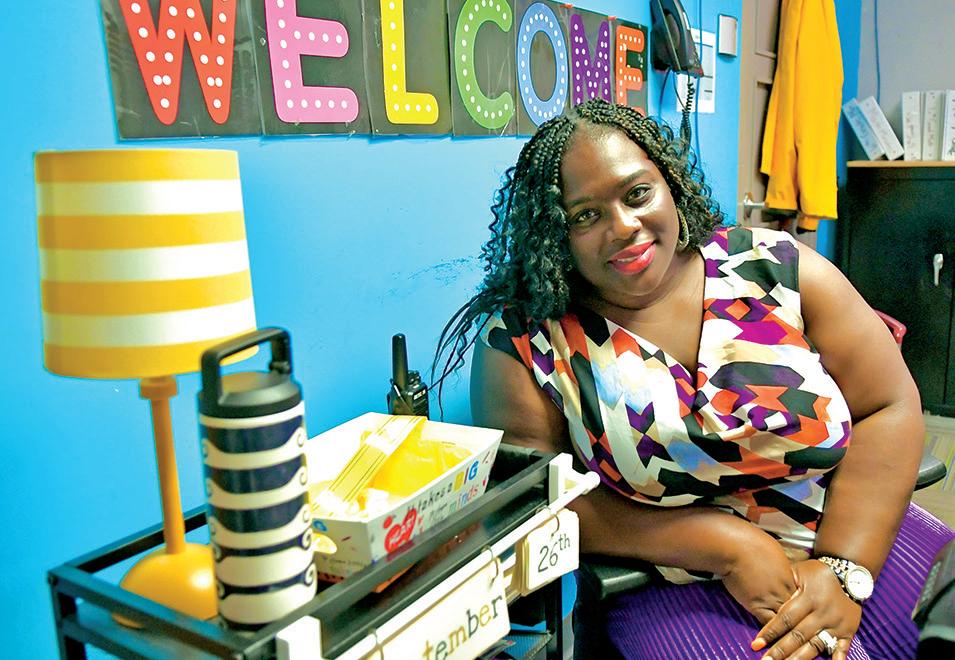
By
Kenya Vaughn St. Louis American
he stunning upgrades to Powell Symphony Hall, along with the architectural elements of the newly created Jack C. Taylor Music Center that wraps around it, reflect a $140 million transformation unveiled in spectacular fashion.
“It’s like an art piece, you know what I mean,” said veteran media personality Robyn Boyce as she made her rounds through the space last week. See SYMPHONY, A13

By Melanie Johnson
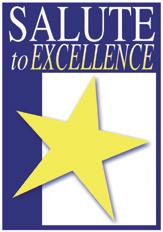
Erica Williams’ life has been a testament to defying the odds. Growing up in north St. Louis as one of 10 children, she endured hardship, including the death of two siblings, one to gun violence. She was determined to rise above those challenges and saw education as the path forward. That determination carried her
Starting with a media preview on Sept. 24, The St. Louis Symphony Orchestra welcomed audiences to the opening weekend for its 146th season. The concerts were the first held in the newly renovated Powell Symphony Hall, which includes the new Jack C. Taylor Music Center. See WILLIAMS, A13 Williams inspires students to believe in themselves


Photo by Taylor Marrie / St. Louis American
Photo by Taylor Marrie / St. Louis American
Erica Williams of Momentum Academy
Photo by Wiley Price / St. Louis American
Fearing a second blacklist?
The March on Washington shows how artists helped bring the last one to an end
By Ben Jealous
Everywhere I go lately, people whisper the same question: Are we sliding into another blacklist era? They point to what happened to Stephen Colbert. They point to what happened to Jimmy Kimmel. They point to other entertainers whose shows, jokes or politics suddenly seemed to cost them work.
The fear is real. The memory of Hollywood’s first blacklist — when actors, writers and directors were cast out of their professions under suspicion of disloyalty or mere association with the left — has never entirely faded. Now, in an age of hyper-partisan media and culture-war politics, it feels dangerously relevant again.
So what do we do about it?
Part of the answer will, as always in America, involve lawsuits. John Henry Faulk’s case against AWARE, Inc. in the 1950s proved that in a courtroom, lies can be punished and reputations can be restored. That victory helped to collapse the blacklist. But legal action, powerful as it can be, has never been the whole story.
The final, cultural death knell of the blacklist came not from a judge’s gavel, but from a march.
On Aug. 28, 1963, hundreds of thousands gathered at the Lincoln Memorial for the March on Washington for Jobs and Freedom. The headliners were Dr. Martin Luther King Jr. and A. Philip Randolph.
than the Black activists themselves. His courage was echoed decades later by his daughter, Soleil Moon Frye — Punky Brewster to a generation — who was arrested with me outside the White House protesting for voting rights. That’s what solidarity across generations looks like.
Here’s the crucial point: Those artists protected each other. One lone actor might have been blackballed. But when Brando, Poitier, Belafonte, Heston, Newman, Woodward, Garner, Lancaster, Carroll, Horne, Frye and others all stood together, the studios couldn’t punish them all. Safety came in numbers. Their collective presence made clear that the blacklist had lost its grip.
The very next day, King and Randolph headlined a socialist convention — the kind of gathering that, a decade earlier, could have landed every participant on a blacklist. Two days later, the actors who had risked standing in Washington went back to work. Their phones still rang. The studios still hired them. Their careers were intact.

But scattered throughout the crowd — and seated in solidarity near the stage — were some of the biggest stars in Hollywood: Sidney Poitier, Harry Belafonte, Lena Horne, Charlton Heston, Marlon Brando, Paul Newman, Joanne Woodward, James Garner, Burt Lancaster, Diahann Carroll and more.
And I say this as someone who has studied and lived these movements: Virgil Frye was there too — and he helped organize them to get there. Frye, later remembered for his role in Easy Rider, was a working actor whose career was scarred by the blacklist, forcing him to shift into directing.
Yet he still took enormous risks to support the movement. As a white man traveling to places like Gadsden, Alabama, he stood shoulder-to-shoulder with Black organizers at a time when “race traitors” were often punished more brutally by white Southern police — and in some cases, feared more by segregationists
In short: They had gone to Washington to demand freedom for Black Americans, and they returned home with a renewed freedom of their own. By breaking the unwritten rule of silence — and by showing courageous love in standing with those most under attack — they showed the industry and the country that the blacklist no longer held. That’s the deeper lesson for us now. Lawsuits may help. Court battles may chip away at injustices. But the true end of a blacklist comes when artists, workers and citizens together refuse to play by its rules. When they stand up publicly — in solidarity, in courageous love — they rob the blacklist of its power.
If we are, in fact, drifting toward a second blacklist era, the way out will look familiar. Not only in the courtroom, but in the streets. Not only in legal victories, but in the collective courage of people willing to risk their own status to defend the dignity of others. The artists who marched in 1963 helped to liberate Black people. And they also helped free themselves.
Ben Jealous is a professor of practice at the University of Pennsylvania, the former head of the NAACP, and the son of two civil rights workers — one Black and one white — who both took great risks in the movement.

Commentary Fox News ignores Brian Kilmeade’s violent rhetoric
By Marc H. Morial
“This is not a simple slip of the tongue. This remark promotes violence against some of the most vulnerable members of our society — people experiencing homelessness and serious mental illness. It dehumanizes them, reduces their lives to disposable inconveniences, and implicitly endorses state-sanctioned violence.” Those words are from a Change.org petition demanding termination of Fox News host Brian Kilmeade.
A late-night talk show host on ABC suggested the Trump administration is exploiting the murder of right-wing provocateur Charlie Kirk to score political points. Under pressure from the Trump administration, the network immediately pulled his show off the air.
A political analyst on MSNBC reacting to news of shots fired pointed out that Kirk’s own incendiary rhetoric contributed to a violent political climate. The news had not yet broken that Kirk was killed or even hit. The network fired him before the end of the day.
A Washington Post columnist posted on social media that the “absolution for white men who espouse hatred and violence” is “part of what keeps America violent.” The Post called her comments “gross misconduct” that endangered “the physical safety of colleagues” and fired her.
harder to believe considering his long history of inflammatory comments. He criticized Americans for inter-cultural marriage while praising the “pure genes” of Sweden. He falsely claimed, “all terrorists are Muslim.” He dismissed the mistreatment of immigrant families, saying “These aren’t our kids … it’s not like [Trump] is doing this to the people of Idaho or Texas.” He attacked the judge who approved a search warrant against Trump, displaying a Photoshopped image of Ghislaine Maxwell giving the judge a foot massage.
Unlike the comments that got Jimmy Kimmel, Matthew Dowd and Karen Attiah fired, Kilmeade’s statements are both hateful and misleading. His call to execute the homeless was so shocking, in fact, that some right-leaning social media users refused to believe he even said it.
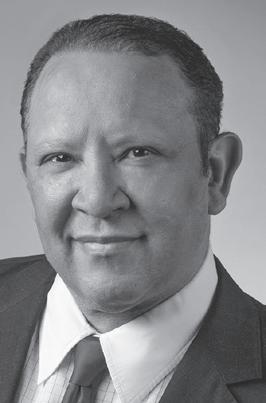
In the days after Kilmeade’s statement, at least 14 petitions calling for his dismissal sprung up on Change.org, garnering more than 19,000 signatures. Some of the petitioners cite their own experience with homelessness or the experience of a friend or relative.
But the Fox News host who called for the execution of mentally ill homeless people still has his job. Kilmeade has faced no repercussions. The network has not uttered a word to denounce his comments.
Days after Kilmeade suggested “involuntary lethal injection or something, just kill ’em,” 13 homeless people were wounded in two separate mass shootings in Minneapolis.
With its silence, Fox not only sanctions the substance of Kilmeade’s abhorrent statement, but embraces a double standard that glorifies the most extreme incitement to violence from the right while suppressing valid criticism of the right.
It’s not even a question of whether we want to live under that standard, but whether we can.
While it’s hard to believe Kilmeade still has a job after his blatant endorsement of unjustified violence, it’s even
“I know the struggles of living without a home, the fear, the uncertainty, and the continuous fight for dignity. Working with the homeless, I witness their resilience, their hopes, and their dreams. Kilmeade’s statement is not just reckless; it is a direct attack on human rights and dignity. Such views have no place in our society, especially from a public figure with significant media influence,” Rio Phillips wrote.
All of the petitions mention the duty of Fox News to demonstrate its commitment to journalistic standards and basic human decency.
“Taking strong action against such conduct is not just a matter of corporate responsibility but a social imperative,” petitioner John Davis wrote. “By terminating Brian Kilmeade’s contract, Fox News can affirm its commitment to journalistic integrity and the wellbeing of all individuals, regardless of their socio-economic status or health conditions.”
Marc Morial is president and CEO of the National Urban League.
Racist rants are not protected speech
By Wilmer J. Leon, III
Charlie Kirk was shot dead Sept. 10 while speaking at a political event in Orem, Utah. Authorities have arrested Utah resident Tyler James Robinson, 22. He allegedly confessed to the shooting to a family member.
Kirk’s shooting has triggered a national discussion about the political significance and/or impact that it will have moving forward. There are two basic elements of analysis of this event for me: the human element and the political.
From the human perspective this was first-degree murder. Murder is wrong. I cannot condone it nor advocate for it in any circumstance.
From the political perspective, we must be very clear. Charlie Kirk was no martyr. He was an angry, ignorant, intolerant, xenophobic, racist, hate-spewing white supremacist. There are far too many in mainstream media and politics who are doing everything in their power to turn the killer’s horrific act into a referendum or validation of whatever agenda they are trying to promote. Trump has ramped up his attacks on “the radical left.”



they can speak freely.”
In theory, Cox is correct, but political speech is not what this should be about. As citizens, we cannot afford to be lulled into this trap equating racist rhetoric with protected political speech.
Kirk said on May 19, 2023, “it’s happening all the time in urban America, prowling Blacks go around for fun to go target white people, that’s a fact. It’s happening more often.” That’s not political speech; that’s unprotected racist hate speech. Isn’t it ironic that Kirk’s alleged assassin is not one of those “prowling Blacks” and is from Orem, Utah?
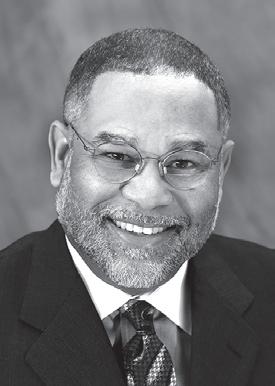
Kirk said on May 19, 2023, “MLK was awful. He’s not a good person.” That’s not political speech. Those comments have no social value. On Jan. 23, 2024, Kirk said, “If I see a Black pilot, I’m going to be like, boy, I hope he’s qualified.”
According to him, “We’re dealing with a radical left group of lunatics, and they don’t play fair, and they never did.”
Others, like Utah Gov. Spencer Cox, are trying to turn this into a discussion about political speech without examining the content of that speech and too many on the so-called “Left” are allowing them to do this. Cox said, “political violence is different than any other type of violence” and that killing Kirk because of his speech “makes it more difficult for people to feel like they can share their ideas, that
The faux-martyrdom for Kirk reminds me of a scene from Godfather I. The character Hyram Roth was talking with the character Mike Corleone about the murder of Roth’s friend, Moe Greene. Roth says, “When I heard it, I didn’t get angry. … I knew Moe, he was talking loud, saying stupid things, so when he turned up dead, I let it go.” Kirk was talking loud, saying racist things. When you make your living like the Charlie Kirk’s of the world, contributing to the ignorant, racist, xenophobic, intolerant white supremacist hate-filled mélange that passes for political dialog, you run the risk of running up against someone who is just a little more intolerant that you; and bad things can happen.
Wilmer Leon is a nationally broadcast radio talk show host and author of the book, “Politics: Another Perspective.”
Guest Columnist Ben Jealous
Columnist Marc Morial
Guest Columnist Wilmer J. Leon, III
““ICE

By Wendy Todd St. Louis American
Illinois Supreme Court
Justice P. Scott Neville Jr. will become the court’s 123rd chief justice and only the second Black jurist to hold the post. His peers selected him to succeed Chief Justice Mary Jane Theis, who will continue as an associate justice when he assumes the top leadership position on Oct. 26.
As chief justice, Neville will oversee the administration of Illinois’ courts — more than 900 judges statewide — while supervising committee appointments, guiding the Illinois Judicial Conference and presenting the court’s annual budget to the General Assembly. But colleagues and observers say Neville brings more than administrative skill; he brings a jurisprudence shaped by a lifelong commitment to civil rights, fairness and constitutional protections.
“Justice Neville has demonstrated a deep commitment to justice and fairness throughout his distinguished career,” Theis said. “I am confident that
he will continue to uphold the integrity of the Illinois Supreme Court as its next Chief Justice.
Born in Chicago to attorney P. Scott Neville Sr. and Alice Dempsey Neville, he grew up surrounded by examples of hard work and advocacy, according to his Illinois Supreme Court biography. His grandmother instilled discipline, his father pressed him to become an orator and his mother urged him to be a strong writer.
Neville earned a bachelor’s degree in history from CulverStockton College in Canton, Missouri, and received his law degree from Washington University School of Law.
A consistent equal justice advocate, Neville, launched his legal career in 1974 as the first Black law clerk to an Illinois First District Appellate Court judge, Glenn T. Johnson. He later built his own firm and argued major civil rights cases — including a challenge of a Chicago ward remap in the 1990s as a member of a legal team that included future U.S. President
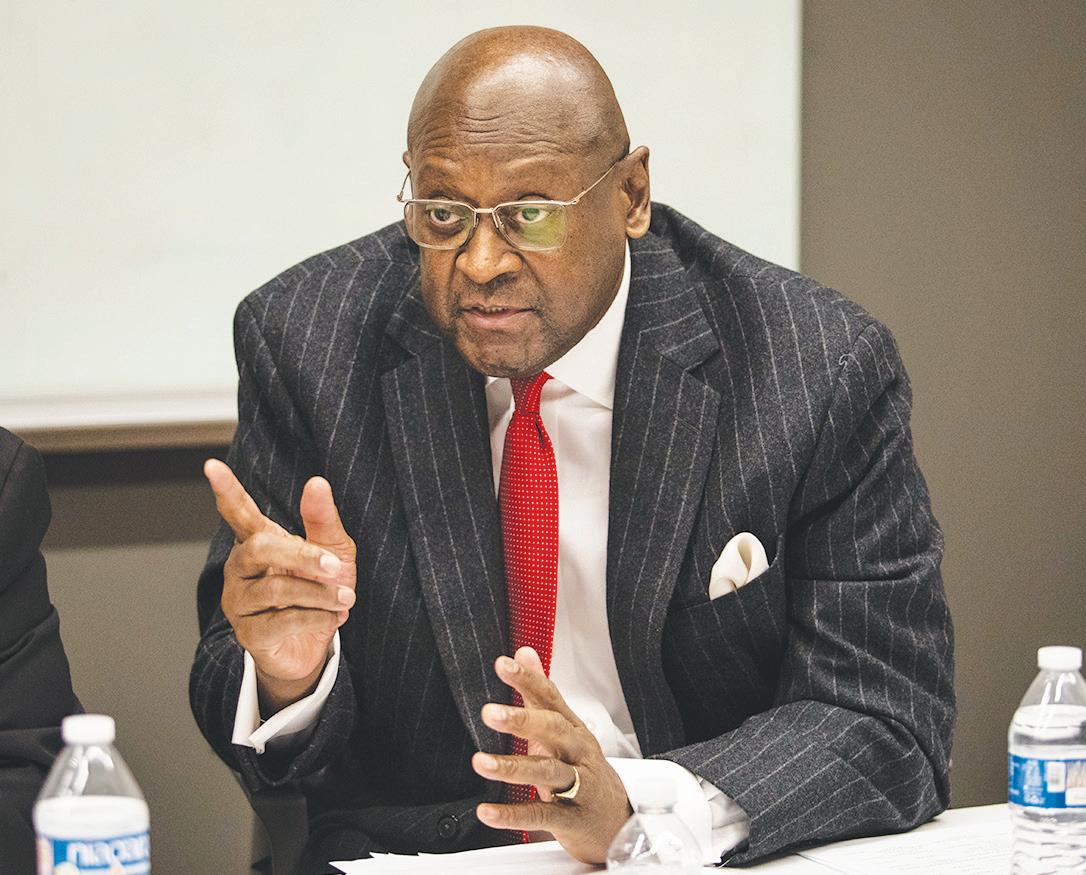
Barack Obama. Neville was elected to the Cook County Circuit Court in 2000, appointed to the Illinois Appellate Court in 2004, appointed to the Illinois Supreme Court in 2018 to fill the vacancy left by Justice Charles E. Freeman, the first Black justice to serve on the court and its chief justice from 1997 to 1999. Neville was elected to a 10-year term in 2020.
Throughout his career, Neville has not shied away from challenging prec-
edent when he believed constitutional rights were at stake. His judicial philosophy is marked by vigilance in protecting defendants and ensuring fairness across the system.
In 2019, he authored the opinion striking down a 50-year sentence for a 16-year-old to a de facto life term that violated the Eighth Amendment of the U.S. Constitution. “This is the most significant decision I have written in my 20 years of judicial service,” Neville said in
a 2020 interview with the Chicago Sun-Times, noting its impact on an estimated 128 juvenile cases statewide.
Also in 2019, he overturned a gun conviction, questioning how the court relied on testimony from a gang expert. In a separate case a year earlier, he argued it was “manifestly unfair” to put all the responsibility on defendants to clear wrongful convictions from their records. “The State should be required to undertake
that responsibility,” he wrote, urging prosecutors and courts to take the lead in erasing convictions based on unconstitutional laws. His voice has often been strongest in dissent. In 2019, he warned that a defendant’s right to a fair trial had been compromised by a trial judge’s off-the-record comments to a jury. Years earlier, as an appellate justice, Neville was the lone dissenter who found Illinois’ ban on carrying firearms unconstitutional — a position the Illinois Supreme Court later adopted.
“I have been on the battlefield my entire life fighting to improve the lives of all people,” Neville told the Sun-Times in 2020. Neville has also emphasized access to justice outside the courtroom. He cofounded the Alliance of Bar Associations to evaluate judicial candidates, served as president of the Cook County Bar Association, and has long supported scholarships for law students from underrepresented backgrounds. Upon his election to chief justice, Neville pledged to strengthen public trust.
“I will always work to make the Illinois courts a national model, safeguarding the constitutional promise of equal justice without regard to who a person is, where they live, or what resources they have so all litigants are seen and heard,” he said.
Photo by Ashlee Rezin / Chicago Sun-Times Justice P. Scott Neville Jr. will become the next chief justice of the Illinois Supreme Court on
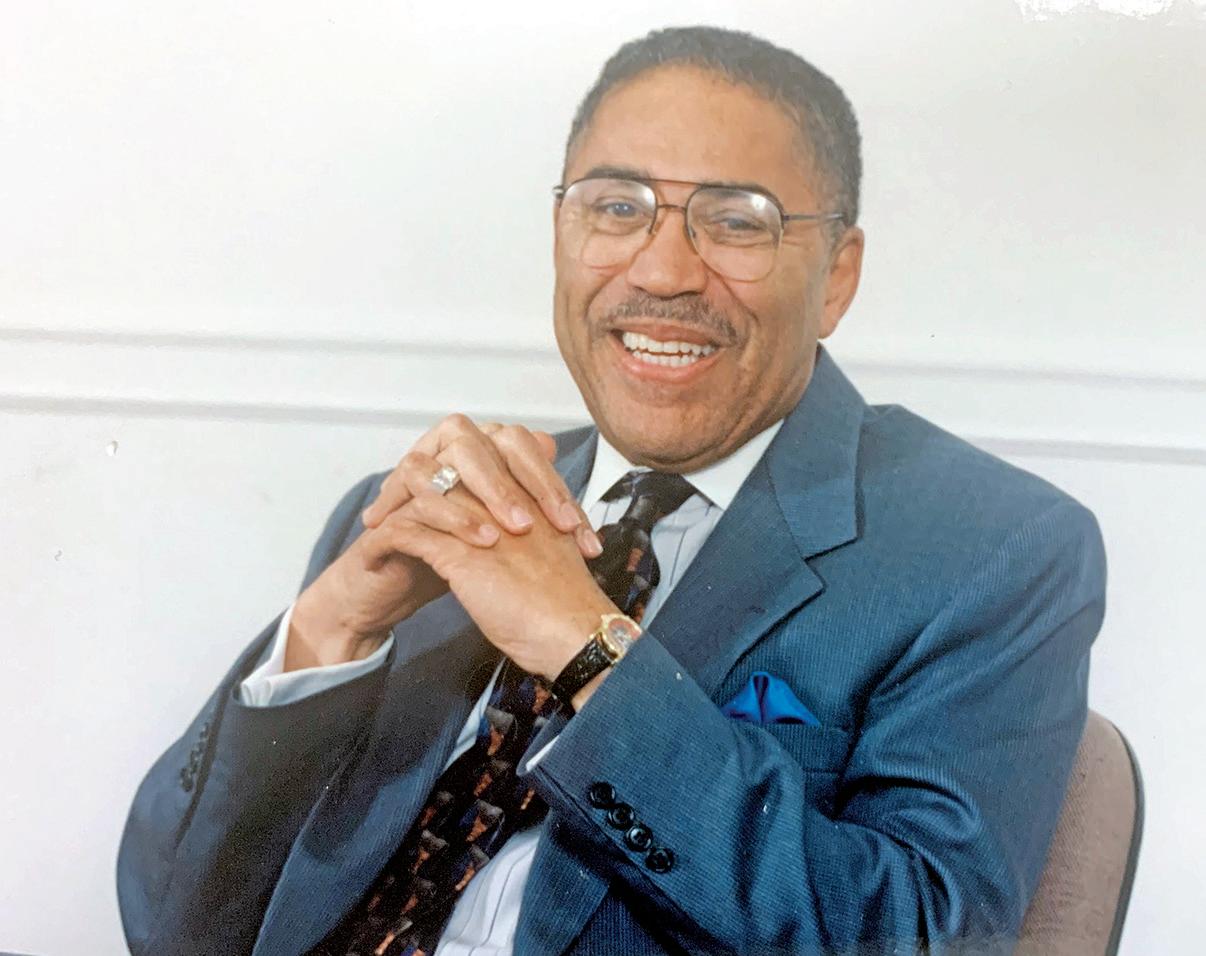
Bell proposes stamp to honor Missouri trailblazer William L. Clay Sr.
St. Louis American staff
U.S. Rep. Wesley Bell would like Americans to have the option of using a postage stamp carrying the image of the late former U.S. Rep. William L. Clay Sr. Bell formally proposed the stamp in a House bill introduced Sept. 17.
“William Lacy Clay Sr. was a giant — not just for St. Louis, not just for Missouri, but for the entire country,” the Democratic congressman said. “A commemorative stamp is a small but lasting way to honor his enormous impact — and to remind future generations of the values he stood for.”
Clay served in Congress for three decades, representing Missouri’s First Congressional District, the St. Louisarea district Bell now serves. Bell noted that Clay fought for civil rights, working people, and “those too often left out or
unheard.
“His legacy lives on in the movement he helped build, the Black lawmakers he helped lift up, and the community he never stopped serving.”
Clay became the first African American to be elected to Congress from Missouri in November 1968 and was a founding member of the Congressional Black Caucus.
“Known for his unwavering commitment to principle, Clay left an indelible mark on labor rights, education, and civil rights legislation,” Bell said.
Clay, who died on July 16, 2025, retired in 2001. He was succeeded by his son, former U.S. Rep. William Lacy Clay Jr., who served for two decades.
Republican U.S. Reps. Jason Smith and Sam Graves, both of Missouri, are among the cosponsors of the bill.
Minor voices, major warnings
By Barbara Reynolds
Stephen Colbert and Jimmy Kimmel — giants of late-night television — have faced censorship, dismissal or forced silence because their words crossed the powerful. That should alarm us all. If media figures of their stature can be muzzled, what chance do ordinary journalists or community truth-tellers have?
I know this pain personally. Decades ago, I was among the first Black women to sit on the editorial board of a major newspaper. I was eventually pushed out — not because of poor work, but because my views did not align with the white male owners. They praised the virtues of free press while silencing those who tried to practice it.
“minor” in my case is now playing out on a much larger and more dangerous scale. In-house censorship has metastasized, and it increasingly resembles the playbook of dictatorship.
President Donald Trump has made no secret of his disdain for independent media. He has pressured networks like ABC and CBS to soften unfavorable coverage. He has filed defamation suits against The Wall Street Journal and The New York Times. His allies in Congress stripped federal funding from NPR and PBS. The FCC, under his influence, has targeted diversity, equity and inclusion programs while vowing to root out what he calls “liberal bias.”
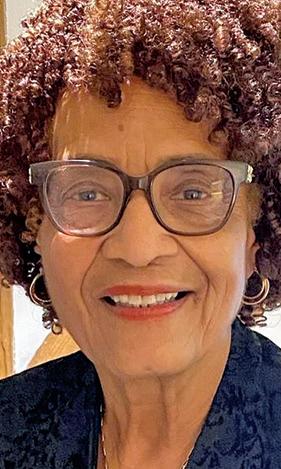
The issue is not new. It is the age-old clash between voices that speak truth from the margins and systems that demand loyalty to privilege. When I wrote about poverty, inequality or the struggles of ordinary people, I was not being rebellious. I was testifying. But privilege prefers a flattering portrait over an honest mirror.
It was often painful to see stories that were crucial to the health and welfare of people of color considered not news or heavily edited, which diluted their importance. For example, I investigated how Medicaid policy actually destroyed the practices of African American doctors, leaving not only their patients medically neglected but fractured the livelihood of the doctors. If this condition had not been centered in the Black communities, it would have been front-page news. But pushing for coverage of these kinds of stories aided in my exit. My honesty cost me my livelihood. My words were branded a “poison pen,” too inconvenient, too unwilling to play along. What was brushed aside as
Distinguished Black journalists have been washed out. At The Washington Post, opinion columnist Karen Attiah was dismissed after she challenged right-wing commentator Charlie Kirk’s demeaning claim that Black women — including Michelle Obama and Justice Ketanji Brown Jackson — “lack brain processing power.”
The attack on the press goes further. The administration has imposed restrictions on journalists covering the Pentagon, requiring them to pledge not to report information unless it has been officially authorized. If such rules stand, they won’t stop at the Pentagon — they will spread across agencies, handcuffing reporters from doing the very job democracy depends on.
Silencing voices — whether latenight hosts or unknown columnists — does not erase the truths they speak. It only deepens the divide between those who hold power and those who live with its consequences.
Barbara Reynolds was a columnist and editorial board member at USA Today for 13 years.

U.S. Rep. Wesley Bell has proposed honoring the late former U.S. Rep. William L. Clay Sr., above, with a commemorative postage stamp.
Photo by Wiley Price / St. Louis American
Barbara Reynolds
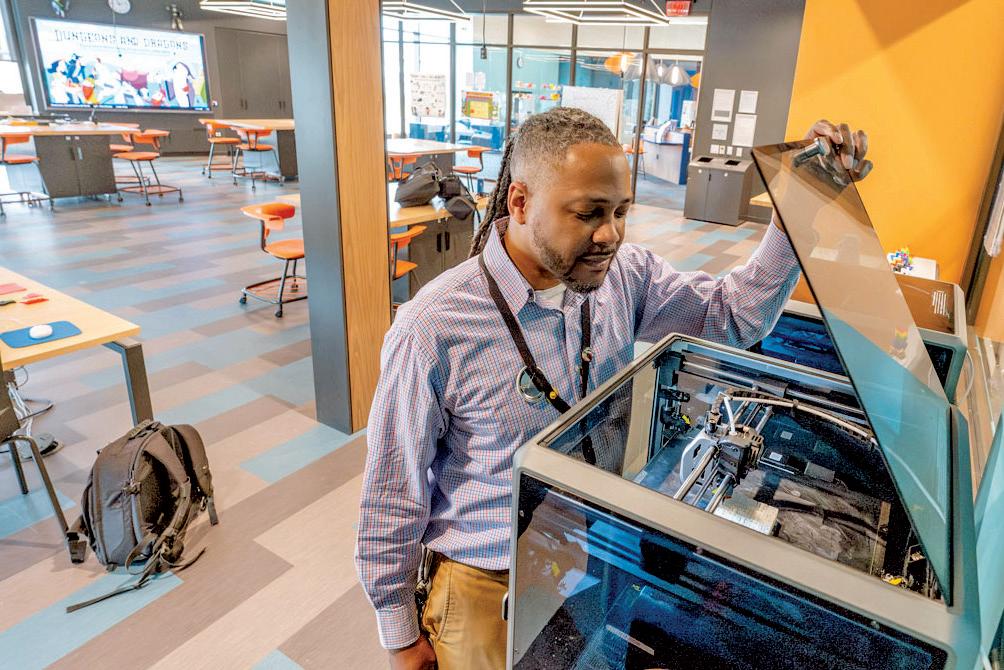
‘This isn’t a traditional library anymore’
Library’s free conference helps St. Louis entrepreneurs and nonprofits launch and grow
By St. Louis American Staff
The mere thought of starting a business or launching a nonprofit can be daunting, even for those with unlimited resources. For individuals or groups seeking to do so with limited funds and little-to-no experience, developing their idea into a sustainable business model can seem insurmountable.
Access to information and learning the basics are a step in the right direction, but even that can be an obstacle for those unfamiliar with the process.
See LIBRARY, A6
Capital denied
High loan rejection rates undercut Black entrepreneurs’ growth
By Stacy M. Brown Washington Informer
A new LendingTree analysis reveals that America’s promise of opportunity remains unevenly distributed.
In 2024, 39% of Black-owned businesses were denied a loan, line of credit or merchant cash advance, the highest rejection rate of any racial or ethnic group. Hispanicowned businesses followed at 29%, while just 18% of white-owned businesses faced denial. The overall numbers may appear steady, but they mask deep disparities.
In 2024, 39% of Blackowned businesses were denied a loan, line of credit or merchant cash advance, the highest rejection rate of any racial or ethnic group.
“Navy Federal Credit Union data revealed they denied African American home loan applications at a rate of 52%, Latino home loan applications at a rate of 44%, and white applicants at a rate of just 23%,” attorney Ben Crump wrote on X in February 2024. “We will continue to fight for those affected by this disparity in lending!” Nationally, 21% of businesses that applied for financing in 2024 were denied, nearly unchanged from 22% in 2023. However, the burden was not shared equally.
The St. Louis County Library has become one of the region’s leading small business generators. Entrepreneurs can use small business resources there and save as much as $13,000 or more, according to the library.
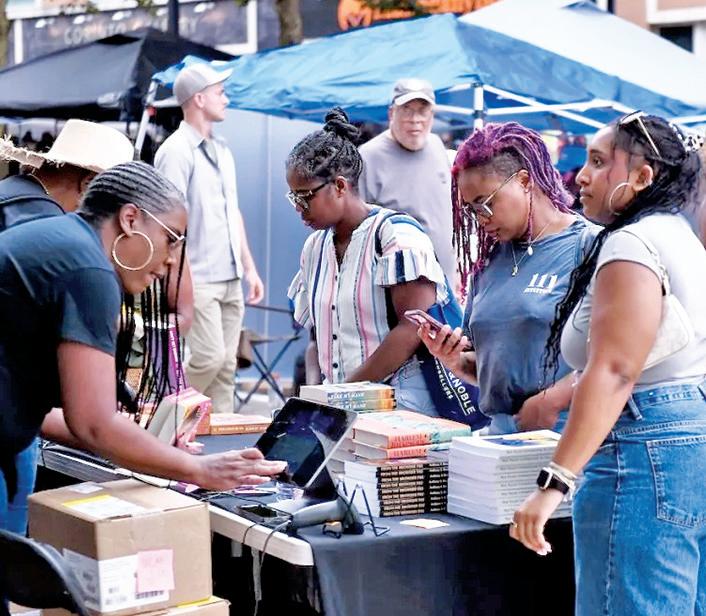
New LendingTree data reveals disparities in Black-owned businesses getting loans. Small firms, startups, and minority-owned companies carried the heaviest weight. Firms with one to four employees were denied 26% of the time, five times the rate of larger firms. Businesses operating between three and five years, often the make-or-break stage for entrepreneurs, faced the highest rejection rate at 29%. The type of loan also shaped the outcome. Applicants for Small Business Administration loans or lines of credit were turned away nearly half the time, with 45% denied in 2024. Personal loans, often used by entrepreneurs who cannot access business
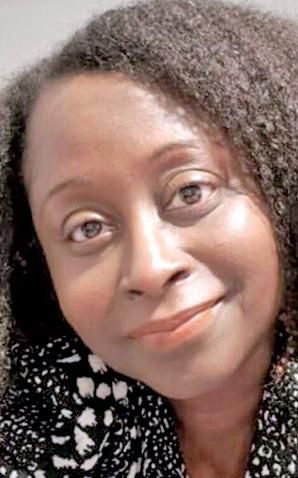
Washington serves as an associate professor of computer science at Howard University, where she founded the Affective Biometrics Lab. Her research focuses on affective computing, biometrics and human-centered design — work that explores how technology can better recognize identity, emotion and
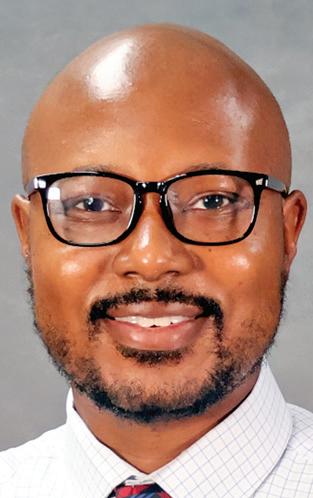
Photo by Robert R. Roberts / The Washington Informer
Ja’Mel McCaine is the manager of the creative lab space at the Clark Family Branch of the St. Louis County Library. The library will host a Small Business & Nonprofit Conference on Oct. 8-10.
Photo by Derik Holtmann / University Missouri St. Louis
Lincoln University graduate Dr. Gloria Washington, Class of 2000,
Washington honored by EBONY as
Gloria Washington
Continued from A5
Fortunately for those in the region, the St. Louis County Library is again providing invaluable resources for emerging entrepreneurs and organizations through its annual Small Business & Nonprofit Conference.
The free conference, to be held Oct. 8-10, will be packed with “actionable strategies, game-changing insights, and valuable connections,” according to the library. Last year, nearly 1,700 people attended.
“Whether you’re an entrepreneur, a small business owner or a nonprofit leader, you’ll find sessions tailored to help you start, strengthen and grow” a library statement says.
The conference will feature in-person and virtual networking along with sessions on a variety of business-critical skills and strategies. The line-up includes 53 sessions on topics including podcasting, artificial intelligence, cybersecurity, grant readiness, public speaking, video production, business plan tips, fundraising and
Loans
Continued from A5
how financial institutions view smaller, less established, and minority-owned firms as riskier bets, regardless of their potential to contribute to local economies.
Washington, D.C., shows how these national trends play out on the ground.
The District is home to 82,666 small businesses, accounting for 98.2% of all firms and employing

Ja’Mel McCaine stands in the Clark Family Branch of the St. Louis County Library, which offers resources for small business owners and aspiring entrepreneurs, including free programs, meeting spaces, computers, Wi-Fi and a copy center.
board engagement.
There are sessions that teach participants how to launch their business and how to develop and implement a successful business plan. Others include instructions on using smartphones and AI for business growth and marketing through software such as Canva.
nearly half of the city’s workforce.
These businesses added more than 43,000 jobs in a single year, proof of their vitality and importance to the local economy. Yet access to capital has not matched their contributions.
Black entrepreneurs own nearly 29,500 businesses in the city, while Hispanic entrepreneurs own close to 7,000. These firms are central to neighborhood vitality, cultural expression and job creation. Still, they are often blocked from the financing
Legal Services of Eastern Missouri, the Rome Group and A Village For Good are among the organizations that will lead sessions and provide support. Sessions will take place at the Clark Family Branch Library at 1640 South Lindbergh Blvd., and virtually via Zoom. Although
needed to sustain and grow.
In 2023, banks issued only $153.3 million in loans to District firms with revenues under $1 million, according to the Small Business Administration. Lending through small-dollar loans of $100,000 or less totaled $235.1 million. For a city with thousands of minority-owned businesses and persistent economic gaps between communities, those figures represent a deep shortfall.
Institutional prac-

the conference is free, registration is recommended for in-person sessions and required for virtual sessions.
The St. Louis County Library has become one of the region’s leading small business generators. Entrepreneurs can use small business resources there and save as much as
tices add to the divide.
Community development financial institutions, created to serve underserved populations, rejected 34% of applicants nationally. Large banks followed at 31%, and even credit unions turned away more than a quarter of those who applied. For minority-owned businesses in Washington, these numbers show the constant struggle with paperwork, credit requirements, and structural bias that too often leave them without resources.
The impact extends
$13,000 or more, according to the library.
The facility provides free access to databases to build mailing lists, conduct market research and explore grants. In 2024, the library opened a small business center on the second floor of the Clark Family Branch.
The center offers
beyond the businesses themselves. When minority-owned firms are denied access to financing, employees lose jobs, neighborhoods lose services, and families lose opportunities to build wealth. In a city with one of the nation’s highest living costs, every loan denied can mean another business shuttered, another household destabilized and another community weakened.
Matt Schulz, LendingTree’s chief consumer finance analyst, said the lending environ-
resources for small business owners and aspiring entrepreneurs, including free programs, meeting spaces, computers, Wi-Fi and a copy center. There also is a creative lab for emerging entrepreneurs, creatives and organizations.
The lab has 17 Apple iMac desktop computers, all loaded with the complete Adobe suite of creative software, as well as three 3-D printers that are available for use with an active library card and minimal charges.
Teens and adults with a library card are given a $5 credit each month to use on the printers in the lab.
“This isn’t a traditional library anymore,” said Ja’Mel McCaine, who manages the creative lab space at the Clark branch, told the UMSL Daily.
“We’re not a quiet space. You can come and learn in a place with all these resources. A lot of people come in here and say, ‘I didn’t know you had all this!’”
A full schedule and registration details are available at: www.slcl. org/events/small-business-and-nonprofit-conference
ment shows no signs of easing. “Inflation, tariffs, high interest rates and a slow job market are making things tough on small businesses and the customers they’re trying to attract,” he said. “[With] this uncertainty, banks pull back, as they tend to do in risky, unpredictable times. Standards for lending to consumers and businesses have generally been tight for some time, and that’s unlikely to change soon.”
If you build something, make sure it outlives you
By Orvin T. Kimbrough
Over the last five years, I’ve found myself in more and more conversations with business owners wrestling with the same question: What’s next?
They’ve run their race. Built something meaningful. And now, they’re staring at the handoff — and struggling. I’ve noticed they spend a lot of time thinking about the transition, but not a lot of time doing.
And I get it. When you’ve poured your life, your energy, your identity into a business, the idea of letting it go — especially to someone else — is daunting. Most of us want to pass down what we’ve built. It’s natural. But here’s the uncomfortable truth:
What if the next generation isn’t ready to sustain it?
We want our assets to bless — not burden. That requires more than good intentions. It requires planning, wisdom and courage. And sometimes, it means rethinking what we value most because sometimes, we place a higher value on the asset when the real value is in the goodwill — the relationships, the reputation, the rhythm that made it work.
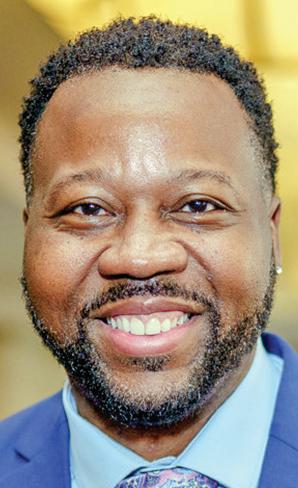
This isn’t just about logistics. It’s about legacy. Legacy isn’t about holding on but about handing off. We often think inheritance is about money. But what if the most important thing we pass on isn’t wealth, it’s mindset?
Lately, I’ve been reflecting on inheritance — not just legal documents or dollar amounts, but the houses, businesses and beliefs we leave behind. And what happens when those assets don’t land in the right hands.
In the North St. Louis neighborhood I came from, there were far more homeowners back in the day. Houses were passed down. But too often, what followed was predictable. The next generation didn’t have the means — or sometimes the mindset — to maintain the property. Eventually, the house would slip away. It’s heartbreaking. Because in neighborhoods like mine, where assets were hard-won and often first-generation, losing them costs more than dollars — it costs momentum. It sets families and communities back. The same thing happens with businesses. Years ago, my Uncle James launched
a lawn care company — a high-cashflow business built on government and private contracts with strong margins. He had a team, equipment and systems in place. I tagged along on a few jobs just to learn — and to be near him. We’d talk about how the business worked and more importantly, what came next. I wanted in. I was early in my career and didn’t have the capital to buy him out, but I offered to take over the business under his guidance and pay him over time. But Uncle James wanted to leave it to his son — who hadn’t shown much interest. Fast forward 20 years: The business is gone. Not because it wasn’t profitable but because there was no succession plan. The goodwill Uncle James built — relationships, reputation, reliability — left with him.
The same thing happened with my cousin Fred. He ran a last-mile delivery business. When he died at just 50 years old, he left no instructions, no successor, no plan. The business, like so many others, died with the man who built it.
Too many of us think we have more time. We delay decisions. We avoid the conversation. But it’s about mortality. It’s about confronting the idea that one day we won’t be here — and asking ourselves if what we’ve built will be.
Between 30% and 40% of U.S. households receive an inheritance. But wealth without wisdom doesn’t last. And legacy doesn’t happen by default.
If you’ve a built anything — a business, a home, a name — ask yourself:
• Have you identified someone who can carry what you’ve built?
• Have they walked alongside you, learned the rhythm, earned the trust?
• Have you made the hard decisions and clearly communicated them?
Sometimes, we assume our kids should inherit what we built. But inheritance is about stewardship — who is best equipped to lead. When we normalize succession, we normalize ownership. And ownership builds freedom. So don’t wait. Schedule the conversation with a successor, a mentor, an advisor.
Because your story deserves more than an ending. It deserves a future.
Orvin T. Kimbrough is chairman and CEO of Midwest BankCentre and author of “Twice Over a Man.”
Orvin T. Kimbrough
Photo by Derik Holtmann / University Missouri St. Louis
HealthMattersHealthMattersHealthMatters
‘Taking Care of You’
Food insecurity
USDA decision to cancel
report slammed
Cracking sickle cell
By Lacretia Wimbley
St. Louis Public Radio
Leaders from one of the largest hunger relief organizations in the St. Louis region says the U.S. Department of Agriculture’s recent cancellation of its annual food insecurity report will do more harm than good. The USDA on Sept. 20 announced it will no longer provide its Household Food Security Report in an effort to save money, stating that


Sticker shock
By Suzanne King Kansas City Beacon
If you are one of the 617,000 people in Missouri or Kansas buying Obamacare insurance on healthcare.gov, expect sticker shock when next year’s premiums are announced. With few exceptions,
By Megan Sayles The Afro
When Dr. Ambroise Wonkam walked into a panel on medical genetics out of curiosity, he had no idea it would shape the course of his career. Born in Cameroon, Wonkam has dedicated his career to studying genetic and genomic variations in African populations and their impact on conditions, like sickle cell disease.
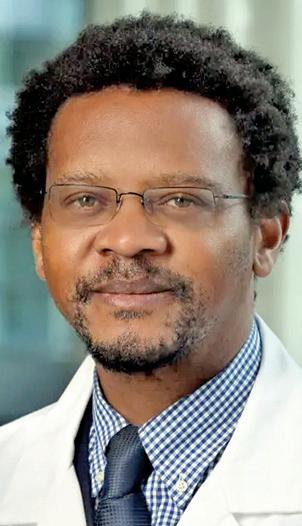
Today, he is the director of the McKusickNathans Institute and Department of Genetic Medicine at the Johns Hopkins University School of Medicine. His father’s advice has been one of the guiding principles behind his work.
“He always said you have to have three major objectives in your life. One was being useful to yourself, the second was being useful to your family and the third was being useful to your nation,” said Wonkam. “My nation is the African nation, and I did not remember seeing a single African at the time who was a geneticist. I thought if I did genetic medicine, I would certainly be useful to my nation.”
Last month, the AFRO connected with Wonkam to discuss the role of genetic modifiers in sickle cell disease and their impact on patient care.
AFRO: Can you explain in simple terms what “genetic modifiers” of sickle cell are?
Ambroise Wonkam: Sickle cell disease is a genetic condition that affects red blood cells. It is caused by a mutation in the gene that makes up the hemoglobin, which is the protein in red blood cells that transports oxygen in our body. It is a condition that evolved in Africa as a variant to confer resistance to malaria if you only have one copy of the mutation. If you inherit two copies of the mutation from your moth-

Courtesy photo
Dr. Ambroise Wonkam
See SICKLE CELL, A8
Operation Food Search office in Overland last week.
Photo by Lacretia Wimbley / St. Louis Public Radio
Continued from A7
The report has been published annually for 30 years and is the largest study of food insecurity in the U.S., providing data on race, ethnicity, age and geographical locations of food deserts across the country. Around 40,000 households and families are interviewed for the assessment as federal, state and local organizations utilize the information to assess needs. In the last report researchers found the food insecurity rate across the country was 13.5% in 2023 and 12.2% the year prior.
The USDA said in a statement that despite the report cancellation, it will “continue to prioritize statutory requirements and where necessary, use the bevy of more timely and accurate data sets available to it.”
The final report under the current presidential administration will be released next month.
But leaders at Operation Food Search in Overland say without this data, acquiring funding will be difficult, as well as uncovering new food-insecure areas. The group distributes $30 million worth of food and necessities each year to 330 community partners in 25 Missouri and Illinois counties —
HealthMattersHealthMattersHealthMatters
$32 million worth of resources were distributed last year.
The company’s president and CEO, Kristen Wild, said the USDA report highlights food deserts by county, which helps determine where to provide resources.
She stressed that the information is crucial to combating rising grocery prices and the potential loss of Supplement Nutrition Assistance Program benefits.
“Food prices over the past five years have increased 30%, so we won’t know the impact of these cuts to safety net programs and continued inflation without having the report on food
Centene subsidiary must return $87.5M to Missouri customers
By Rudi Keller Missouri Independent
Missouri’s biggest individual insurer must rebate almost $90 million to policyholders because it spent too little on care and too much on administration.
Ambetter from Home State Health, a subsidiary of Clayton-based Centene Corporation, is mailing checks totaling $87.5 million to customers in Missouri because it violated the Medical Loss Ratio requirements of the Affordable Care Act, also known as Obamacare. Letters dated Sept. 10 notifying policyholders of the rebates — equal to more than one month’s premium for each — began arriving in mailboxes during the last week or so.
One of Ambetter’s competitors, United Healthcare, is also making rebates to Missouri customers. In a Sept. 5 statement, United Healthcare said it will rebate $192.2 million nationally for group market plans offered in 31 states and $167.1 million for individual insurance market plans offered in 19 states.
insecurity,” Wild said. “Cancelation of the report is not canceling hunger. Hunger is increasing, and we need the data to most effectively deploy the resources to those who don’t have enough healthy food.”
According to OFS, the nonpartisan Congressional Budget Office estimates that 150,000 Missourians and 472,000 Illinoisans will lose SNAP assistance, numbers largely made up of disabled and elderly people, the working poor, veterans and children.
OFS relies heavily on data when applying for grants, Wild said.
“They want to know, who are we serving? What are the food insecurity
rates right now? About a third of kids in St. Louis City do not have the food they need to lead healthy lives. So numbers like that are really impactful and incentivize funders to allocate resources so that we can provide food to those areas.”
Eligibility for school nutrition programs is also being made more difficult, and local food purchase programs have been discontinued, Wild noted.
“It’s not just SNAP, there are several safety net programs in addition to potential Medicaid cuts that obviously will impact people financially, leading to greater food insecurity, including continued inflation,” Wild added.

Continued from A7
istration laws and policies that will increase the cost of coverage, drive healthy people to drop out and leave behind patients who cost the most.
Expiring tax credits and new rules
The first policy pushing up prices is that enhanced tax credits are set to expire.
Since 2021, those credits have offset the cost of health plans for more than 90% of marketplace enrollees and helped double enrollment. They expire at the end of the year if Congress doesn’t renew them.
from A7
er and father, you develop the disease.
In Nigeria, it is known that without treatment, 50% of children will die before their 5th birthday. It’s also the case in Nigeria that without treatment, some children will still live up to 60, which is the life expectancy for sickle cell in America.
The second policy is a new Centers for Medicare and Medicaid Services rule that overhauls how the marketplace operates.
Some changes shorten the enrollment period, eliminate automatic reenrollment and add stricter eligibility checks. Other changes alter how payments are formulated, which could raise premiums and force people to pay more for deductibles and copays.
“The bottom line is that out-of-pocket premiums will go up,” said Gideon Lukens of the Center on Budget and Policy Priorities. “People will pay higher deductibles and copays… And then a lot of people lose coverage as a result.”
Comparable to repealing Obamacare
The ACA marketplace reached more than 24 million enrollees nationally in 2025, including 417,000 in Missouri and 200,050 in Kansas — double 2021 levels.
But those highs are expected to plummet next year as premiums rise. The Kansas Health Institute predicted enrollment could return to 2021 levels and uninsured rates could “greatly increase.”
Next year’s increases come as the Congressional Budget Office projects Trump administration policies will reduce resources for the poorest households between 2026 and 2034.
The CBO said poor households will lose an average of $1,200 annually, while
top-income households can expect to gain $13,600.
“It’s not a repeal of the ACA, but the size of the impact is comparable,” Lukens said. “The way it’s done is more of a deathby-a-thousand-cuts way. … But the overall impact … will be to increase the number of people without coverage by getting close to where we were before the ACA.”
A vicious cycle
Once the dust settles, an estimated 8 million people are expected to lose coverage through the ACA marketplace. Another 9 million could lose Medicaid under federal legislation passed in July, which cuts federal spending by close to $1 trillion and adds new requirements.
Once the dust settles, an estimated 8 million people are expected to lose coverage through the ACA marketplace.
“The worst case scenario here is bad,” said Caitlin Donovan of the Patient Advocate Foundation.
When people lose coverage, they’re less likely to seek care and more likely to get sicker before getting help, which strains hospitals and pushes rates higher.
“There is going to be a sicker population that’s in a much worse situation,” Donovan said.
When young and healthy people drop coverage, leaving behind those who are more expensive to cover, premiums spiral, said Christopher Garmon, assistant professor at the University of MissouriKansas City.
“Anything that makes healthy people less likely to enroll is going to increase costs and cause
Loss of the USDA report will also impact Operation Food Search’s ability to manage and sustain operations, said Chief Operating Officer Carlton Adams. “I mean, you need to be on the street talking to people and really understanding their day to day,” Adams said. “But in addition to that, you need data to back up what you’re doing … how many trucks you need to send … how much we need to change and redouble our efforts around donated food [and] grant money for purchasing food — all of the things that we do to kind of keep the wheels running here.”
premiums to go up… And that is a vicious cycle,” he said.
The Commonwealth Fund estimates that people in Missouri who receive tax credits will see a $720 jump in annual premiums, while those in Kansas will see a $590 increase. Rising premiums in Kansas and Missouri
Most insurers in the two states have requested increases. Medica Insurance Co. said its rates need to go up 29.3% in Kansas and 29.2% in Missouri, while Celtic Insurance Co. proposed a 24.4% hike in Missouri.
Other carriers proposing increases include Oscar Insurance Co., which is asking for a 14.4% jump in Kansas and 11.7% in Missouri, and United Healthcare, which wants a 10.1% bump in Kansas and 10.7% in Missouri. Blue Cross and Blue Shield of Kansas City is the only carrier in the market — and one of just four in the country — planning to lower rates, dropping 6.1% in Kansas and 4.4% in Missouri.
Less help available
Proposed rates must be approved by state regulators before being listed in the marketplace. That should happen this fall in time for open enrollment, which begins Nov. 1. This year, people have until Jan. 15 to enroll. Next year that window shortens to Nov. 1 through Dec. 15. Many may not realize how much the ACA is changing. Earlier this year the Trump administration cut funding for navigators who help people find coverage and also slashed money for public information campaigns. Justin Gust of El Centro Inc. said he’s seen this before: “There was a huge reduction in people enrolling.”
Genetic modifiers are important because they allow us to understand why one kid is very sick and the other is not when they have the same mutation. When we understand those modifications, they can be amenable to therapeutic modifications for treating the condition.
AFRO: What have you learned about these modifiers through your research?
AW: In our research, we have revealed modifiers in many sickle cell disease complications. For example, kidney disease
The question is: how is it that one of two people in the same environment — even if that environment is very harsh in terms of health care provisions — will survive well above their 50s without appropriate treatment? That’s where genetic modifiers come in. If the environment is that bad and you still survive with a very severe condition that suggests that in some part of your body there is some other variant or mutation that improves the severity of the condition in you.
and sickle cell disease are modified by three genes, including one called APOL1. Some clinical studies published last year showed that if you modify that gene by inhibiting it using genetic technology or a pill, you reduce the occurrence of kidney dysfunction. Importantly, this was in people without sickle cell, suggesting that knowledge we have from sickle cell can also help the general population.
We’re also very interested in genetic modifiers of the type of hemoglobin present in babies before they are born. It progressively reduces when we’re born and becomes nearly zero in all of us as adults. If you maintain the capacity to produce fetal hemoglobin at 8%, it positively modifies your disease.
Earlier this year, we
published a study about a fetal hemoglobin modifier that we strongly believe can be a target for therapeutics in the near future.
AFRO: You’ve discussed how Africa is underrepresented in genetic research. Why does this matter for sickle cell patients?
AW: It matters for humanity as a whole. There are three reasons why African genomes, in general, are critical for all of us. The first reason is ancestry. We are all African. The first human being evolved in Africa about 300,000 years ago. Present-day Europeans and Asians moved out of Africa only about 50,000 to 70,000 years ago. Yet, 98% of the genomic data we currently have comes
from people of European ancestry. If we only study those genomes, they only represent a small fraction of humanity variation. The second reason is the geography of Africa. Africa stretches north to south. If you look at Europe and Asia, they’re quite horizontal, extending east to west. Africa crosses many regions with different climates and environments. For example, in Cairo, you have the Mediterranean climate. In Central Africa, you have the rainforest. Different environments have different impacts on your genome. For example, skin color changes based on sun exposure. The third reason is if you have different environments, you also have different types of infection. For example, you don’t
have mosquitos producing malaria in Europe, but you do have it in African rainforests. As a result, the sickle cell mutation evolved in Africa as a survival mechanism to resist malaria.
AFRO: How could more inclusive genetic data change care for sickle cell patients globally?
AW: If you don’t study the African population, you refuse the opportunity of discovering new potential targets for sickle cell disease therapeutics. Additionally, studying African populations does not only improve the care for a condition, like sickle cell in Africans — it also helps us to understand the human genome, improving care for all of us and for many other conditions.
The St. Louis American’s award winning NIE program provides newspapers and resources to more than 8,000 teachers and students each week throughout the school year, at no charge.
St. Louis American’s award winning NIE program provides newspapers and resources to more than 8,000 teachers and students each week throughout the
Questions or comments? Contact Cathy Sewell csewell@stlamerican.com or 618-910-9551
Questions or comments? Contact Cathy Sewell csewell@stlamerican.com or 618-910-9551

Questions or comments? Contact Cathy Sewell csewell@stlamerican.com or 618-910-9551
at no
FAMILY SPOTLIGHT
Students


Students at The American’s Summer Science Academy work in teams to discover the many different computer programming languages.
SCIENCE CORNER



SCIENCE CORNER

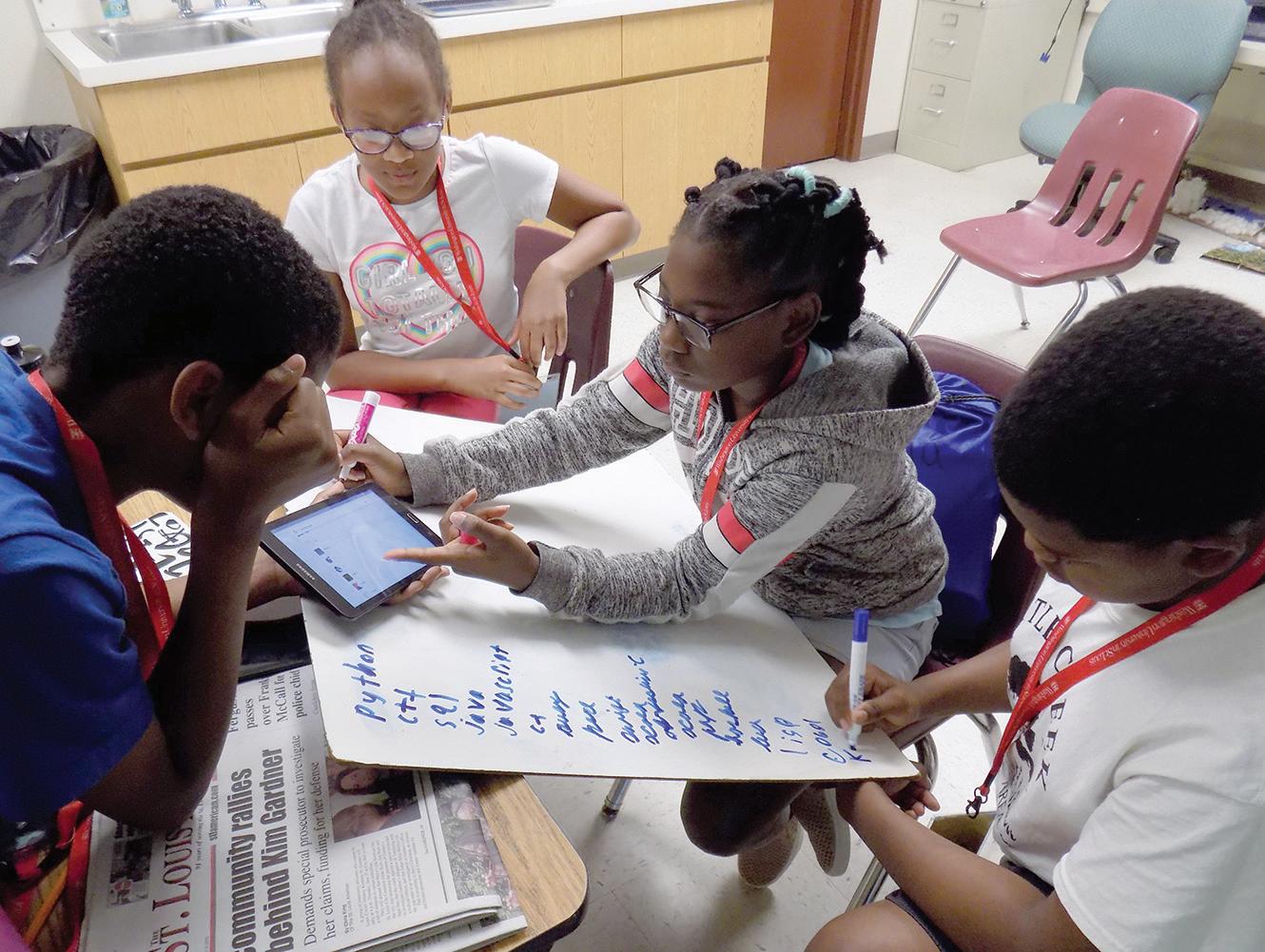

SCIENCE STARS


AFRICAN-AMERICAN MYCOLOGIST AND EDUCATOR:
African American Meterologist William “Bill” Parker
Jeanette Jones
Jordan Taylor: From Sketches to AI-Powered Designs
African American Meterologist William “Bill” Parker
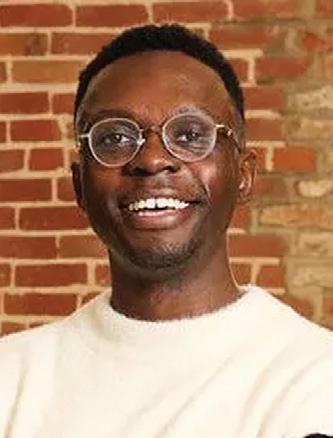
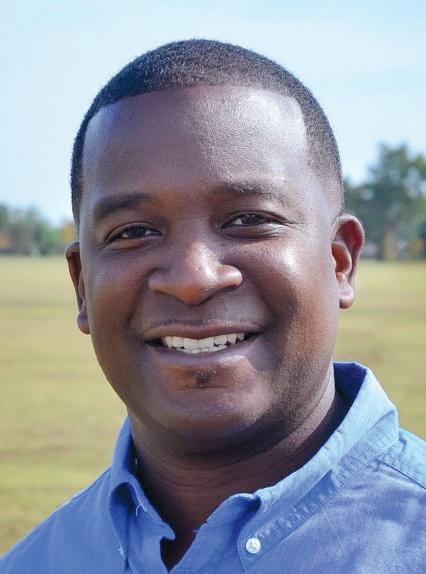

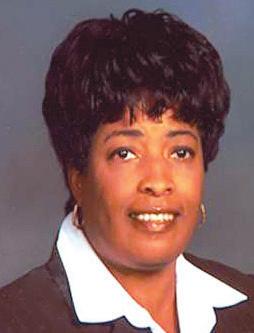
William (Bill) Parker grew up in New Orleans. He graduated from JFK High School, which focused on math, science, and engineering. Parker was interested in hurricanes at a young age, but he became interested in the weather after a high school statistics class. In this class, he learned how to predict the chance of rain. Parker wanted to attend a historically black college/ university (HBCU), so he chose Jackson State University to study meteorology. He graduated with his bachelor’s degree, in 1994.
William (Bill) Parker grew up in New Orleans. He graduated from JFK High School, which focused on math, science, and engineering. Parker was interested in hurricanes at a young age, but he became interested in the weather after a high school statistics class. In this class, he learned how to predict the chance of rain. Parker wanted to attend a historically black college/ university (HBCU), so he chose Jackson State University to study meteorology. He graduated with his bachelor’s degree, in 1994.
Jeanette Jones was born on September 19, 1950, in Fort Valley, Georgia. Jones graduated from Fort Valley State University in 1972 with a bachelor’s degree in biology education. In 1973, Jones received her master’s degree in botany and mycology (a branch of biology that studies fungi) from The Ohio State University. In 1976, she received her doctorate (Ph.D.) degree.
Jordan Taylor is an engineer, designer, and tech founder who uses artificial intelligence (AI) to change how people make things. At only 29 years old, he left his job at Nvidia to start a company called Vizcom with his childhood friend Kaelan Richards. Their goal is to help designers draw ideas by hand and then quickly turn those sketches into 3D designs using AI tools.
A hurricane forms over tropical and subtropical ocean water. Warm water and cool, moist air combine to create strong winds that can gust up to 200 miles per hour! These winds create waves that bring the storm on shore. Hurricanes are very destructive. They can flip cars, sink boats, uproot trees, and demolish houses.
A hurricane forms over tropical and subtropical ocean water. Warm water and cool, moist air combine to create strong winds that can gust up to 200 miles per hour! These winds create waves that bring the storm on shore. Hurricanes are very destructive. They can flip cars, sink boats, uproot trees, and demolish houses.
SCIENCE CORNER



Are Fungi ?
In addition to powerful winds, hurricanes bring a lot of rain. (Taiwan received 114 inches of rain in three days during a hurricane.) These rains can cause landslides and flash floods.
In addition to powerful winds, hurricanes bring a lot of rain. (Taiwan received 114 inches of rain in three days during a hurricane.) These rains can cause landslides and flash floods.
In
SCIENCE INVESTIGATION
SCIENCE INVESTIGATION


Fungi are organisms made of filaments (called hyphe) that are stacked together. Unlike plants, fungi do not have chlorophyll, so they cannot make their own food. Some fungi are parasites, which mean they live off of other organisms. Some fungi feed off of dead and decaying matter. Fungi are everywhere in the environment, including the soil, lakes, river and seas, air, and on plants and animals. Fungi (plural of fungus) help organic matter to decay and release carbon and oxygen into the environment. Unlike plants, fungi do not have
In this experiment, you’ll create a replica of a hurricane and identify how the forces work together to create a hurricane.
SCIENCE INVESTIGATION
Materials Needed:
• 2 Soda Bottles • 3 Paper Clips
• 3 Peanuts • ¼ C. Sand • Funnel
• Water • Duct Tape
Hurricanes can last a few hours or several days. Most hurricanes occur during the fall months. How can you stay safe? Have an evacuation plan and an emergency kit prepared. Meteorologists can track these storms and keep you informed. For more hurricane facts, visit: http://www.sciencekids.co.nz/ sciencefacts/weather/hurricane.html.
Hurricanes can last a few hours or several days. Most hurricanes occur during the fall months. How can you stay safe? Have an evacuation plan and an emergency kit prepared. Meteorologists can track these storms and keep you informed. For more hurricane facts, visit: http://www.sciencekids.co.nz/ sciencefacts/weather/hurricane.html.
leaves, stems, or roots. Fungi use spores to reproduce. One common type of fungus is the mushrooms you find on your pizza. Mold, yeasts, and mildew are also types of fungus.
For More Information, Go to: https://kids.kiddle.co/Fungus
Learning Standards: I can read nonfiction text for main idea and supporting details.
Learning Standards: I can read nonfiction text for main idea and supporting details.
Learning Standards: I can read nonfiction text to gain background information about fungi.
Make Your Own Hurricane!

Materials Needed:
Procedure:
q
create a watertight seal. Continue taping 1 to 2 inches above and below the seam.
create a watertight seal. Continue taping 1 to 2 inches above and below the seam.
Growing Mold!
t Hold the bottles by the middle and lift the jugs.
t Hold the bottles by the middle and lift the jugs.
In this experiment, you will learn how mold grows best. Mold is an important fungus that has several uses, including breaking down dead organic material. Some purified molds are actually used as an antibiotic to treat illnesses.
Procedure:
• 3 slices of bread • Water • 3 Ziploc bags
q Fill one bottle with the paperclips, peanuts and sand. These represent the debris and help make the movement of water easier to see.
• 10x10 square centimeter grid • Ruler
Process:
until it is 3/4 full, then remove the funnel.
w Place the funnel in the mouth of the bottle and pour water into the bottle until it is 3/4 full, then remove the funnel.
q Wet one slice of bread enough to make it moist and place it in a bag. Seal the bag very tightly.
e Turn the second empty bottle upside down and hold it over the first bottle so that the mouths of the bottle are aligned. The bottles will look like an hourglass.
e Turn the second empty bottle upside down and hold it over the first bottle so that the mouths of the bottle are aligned. The bottles will look like an hourglass.
w Place the two other slices of dry bread in two separate bags and seal them, as well.
r Tape the seam, pressing the duct tape firmly to
r Tape the seam, pressing the duct tape firmly to

e Place the bag with the wet slice of bread and one of the bags with a dry slice of bread in a dark place, such as a closed cabinet or closet. Place the third bag with a dry slice
a person who has made contributions to the fields of science, technology, Teachers,

z A hurricane has moved 456 miles in 6 hours. How many miles per hour is the hurricane traveling? ______ If it continues to travel at that speed, how far will it travel in 10 hours? ______
z A hurricane has moved 456 miles in 6 hours. How many miles per hour is the hurricane traveling? ______ If it continues to travel at that speed, how far will it travel in 10 hours? ______
MATH CONNECTION
Jordan grew up loving design and exploring how things are made. His early interest in creating led him to work at Nvidia, where he learned about industrial design and got to see how computers and graphics can work together for new ideas. Then, in 2021 he and Kaelan launched Vizcom, which lets people move from drawing on paper to seeing their idea as a 3D model fast and more easily. Designers, artists, and companies can utilize this tool to experiment with various versions of a product without incurring the time-consuming process of creating each one.
Vizcom has done very well. The company has raised about $25 million from investors, and it has signed big customers like Ford and New Balance. Many companies use Vizcom to speed up the design process, make changes faster, and test ideas in 3D.
She also studied at the University of Nevada, the University of California Medical School, the National Center for Disease Control-Atlanta, and the Massachusetts Institute of Technology. After graduation, Alabama A&M University hired Jones as an assistant biology professor. In 1986, she served as an adjunct professor in the College of Pharmacy and Pharmaceutical Services at Florida Agricultural and Mechanical University and worked on a project with NASA. In 1991, Jones served as the first female vice president of research and development at Alabama A&M University. She also served as President of Alabama A&M University’s Faculty Senate from 2001 to 2006. In 1992, she was appointed to the U.S. Army Science Board by the U.S. Secretary of the Army, Togo West. Since 2004 Jones has been the director of the Center for Biomedical, Behavioral, and Environment Research at Alabama A&M University. She also worked as a consultant with federal agencies to help them develop training programs to attract women and minorities to STEM education and careers.
y Quickly, turn the bottles over so that the water-filled bottle is on top. Set the bottles on the table again.
x Hurricane Frederick is traveling at 86 miles per hour. If the hurricane is 129 miles from the coast, how many hours will it take until the hurricane reaches the coast? ______
y Quickly, turn the bottles over so that the water-filled bottle is on top. Set the bottles on the table again.
u Observe the water as it drains into the bottle below. The water competes with the air from the empty bottle. Both substances push to pass through the neck.
u Observe the water as it drains into the bottle below. The water competes with the air from the empty bottle. Both substances push to pass through the neck.
i Turn the bottles over again. This time, shake the bottles in a circular motion. Be sure to keep the bottles vertical.
i Turn the bottles over again. This time, shake the bottles in a circular motion. Be sure to keep the bottles vertical.
o The water will form a vortex as it drains into the next bottle. The water will flow along the outside of the neck, while air moves quickly up through the center of the vortex. The water will drain much faster.
t For five days, measure the square centimeters of mold on each piece of bread through the bag. Use a grid, if possible, or a ruler. If mold covers more than half a square centimeter, it is counted as one full centimeter. If it is less, it is counted as 0 centimeters. This will give you the area of mold on each slice of bread y At the end of a week (5 days of measuring) or longer, use your final results to say what percentage of the bread was covered in mold. Make a table or graph to display the information.
o The water will form a vortex as it drains into the next bottle. The water will flow along the outside of the neck, while air moves quickly up through the center of the vortex. The water will drain much faster.
Analyze: How did water and air create a hurricane?
Analyze: How did water and air create a hurricane?
Learning Standards: I can follow sequential directions to complete an experiment. I can make observations and draw conclusions.
In 1993, he began to gain experience in the field when he worked as a student meteorologist. One year later, he was a meteorologist intern at Shreveport. In 1998, Parker became a general forecaster, and ten years later, a lead forecaster. In 2012, he became a warning coordination meteorologist (WCM). There are only 122 people with this title in the United States, and Parker was the only African American. Parker is currently the meteorologist-in-charge (MIC) at the National Weather Service, leading a team of 26 weather professionals. Parker is also very active as a volunteer in his community. He is member of the Shreveport-Bossier Mayors’ Prayer Breakfast Executive Committee, La Cima Bilingual Leadership Academy, Bossier Chamber of Commerce Education Committee, Volunteers for Youth Justice, and a coach for Bossier Parks and Recreation. Parker is also an associate minister at Elizabeth Baptist Church in Benton, where he has been serving the congregation since 1997.
In 1993, he began to gain experience in the field when he worked as a student meteorologist. One year later, he was a meteorologist intern at Shreveport. In 1998, Parker became a general forecaster, and ten years later, a lead forecaster. In 2012, he became a warning coordination meteorologist (WCM). There are only 122 people with this title in the United States, and Parker was the only African American. Parker is currently the meteorologist-in-charge (MIC) at the National Weather Service, leading a team of 26 weather professionals. Parker is also very active as a volunteer in his community. He is a member of the Shreveport-Bossier Mayors’ Prayer Breakfast Executive Committee, La Cima Bilingual Leadership Academy, Bossier Chamber of Commerce Education Committee, Volunteers for Youth Justice, and a coach for Bossier Parks and Recreation. Parker is also an associate minister at Elizabeth Baptist Church in Benton, where he has been serving the congregation since 1997.



In 1975, Jones was listed in the World’s Women’s Who’s Who and she was named an Outstanding Young Woman of America in 1978. Beta Beta Beta National Biological Honor Society awarded her the distinguished service award. Jones also received the Significant Service Award from the NASA Space Life Sciences Training Program and the Extramural Associate Research Development Award from the National Institute of Health. In 1990 and 2006, she was named Woman of the Year at Alabama A&M University and was given the Outstanding Leadership Award by the Faculty Senate. The U.S. Army presented Jones the Commander’s Award for Outstanding Civilian Service as a member of the Army Science Board.
Parker believes in serving as a role model to the youth and to recruiting African Americans in the STEM field. Personally, he has hired three African-American meteorologists. In addition, he has recruited minorities for summer intern positions.
In some cases, enterprises pay large sums, while smaller users pay a smaller monthly fee to use the platform. What Jordan does is important in engineering and design because he shows how AI can help people work smarter, not harder. By automating parts of the design process, designers can focus more on being creative and solving problems, instead of spending all their time redrawing or fixing details. This helps make design faster, cheaper, and more accessible. For students, Jordan Taylor’s story is inspiring because it combines curiosity, creativity, and technology. He teaches us that even if you like drawing, sketching, or building with your hands, you can also learn new tech like AI and software to make your ideas real. It shows that problem-solving, imagining better ways, and being brave enough to try new tools can lead to making things that matter. Maybe one day you’ll make a tool that helps everyone design faster, too. How did Jordan Taylor’s early interests in design and technology shape his career path?ESS1.A.1 – Patterns of the sun, moon, and stars can be observed to describe predictable patterns.
Learning Standards: I can follow sequential directions to complete an experiment. I can make observations and draw conclusions.
Discussion Questions: How much mold was on the bread? Which location had the most mold? Which had the least? What conclusions can you draw about the conditions in which mold grows? How can food manufacturers and restaurant owners use this information to help them?
Math Storms!
Math Storms!
Learning Standards: I can follow sequential directions to complete an experiment. I can display my results, make observations, and draw conclusions.

X has grown to have wind speeds of 48 miles per hour. How much faster will the winds have to become for Tropical Storm X to become Hurricane X? ______
Scientists often use tables and graphs to display the results of their research. Looking at these displays, you can draw conclusions.
x Hurricane Frederick is traveling at 86 miles per hour. If the hurricane is 129 miles from the coast, how many hours will it take until the hurricane reaches the coast? ______
c A tropical storm takes on a hurricane status when the winds reach 74 miles per hour. After three days, Tropical Storm
c A tropical storm takes on a hurricane status when the winds reach 74 miles per hour. After three days, Tropical Storm
YOU KNOW?

DID YOU KNOW?

DID YOU KNOW?
Analyzing a Bar Graph
As we approach spring weather (and increased rain), create a bar graph that displays the amount of rain that falls for several consecutive days or weeks. (Day 1: 1.5 inches, Day 2: 0 inches, Day 3: 1.5 inches, etc.)
v Upon landfall of a Category 4 hurricane, local officials ordered an evacuation. City A has a population of 9,613, City B has a population of 5,013 and City C has a population of 3,972. How many people were evacuated in all?
X has grown to have wind speeds of 48 miles per hour. How much faster will the winds have to become for Tropical Storm X to become Hurricane X? ______ v Upon landfall of a Category 4 hurricane, local officials ordered an evacuation. City A has a population of 9,613, City B has a population of 5,013 and City C has a population of 3,972. How many people were evacuated in all?
$115,264 in damage, City B reported $236,096 and City C reported $436,869 in damages. What was the total cost of damages rounded to the nearest thousand? ______ If the state and federal government promised $500,000 in aid, how much would the local people have to raise by themselves? ______
$115,264 in damage, City B reported $236,096 and City C reported $436,869 in damages. What was the total cost of damages rounded to the nearest thousand? ______ If the state and federal government promised $500,000 in aid, how much would the local people have to raise by themselves? ______
Discussion Questions: Which day had the most measured rainfall? Which day(s) had the least? Looking at the bar graph, what might you conclude about rain patterns in March/April? What other observations can you make?
Learning Standards: I can add, subtract, multiply, and divide to solve a problem.
Learning Standards: I can use a bar graph to display information. I can use the information to make deductions and inferences.
b After citizens returned to their houses after the evacuation, reports of damage were totaled. City A reported
b After citizens returned to their houses after the evacuation, reports of damage were totaled. City A reported



There are over 10,000 species of mold, with 1,000 of those species found in the United States.

This special Newspaper In Education initiative is made possible, and delivered to classrooms through the St. Louis American Foundation and its NIE Corporate Partners:

Learning Standards: I can add, subtract, multiply, and divide to solve a problem.





Parker has also mentored an Airline High School student for his senior project. Parker’s advice to students interested in meteorology is to take as many math and science classes as possible. Learn about summer opportunities in your community. If you are interested in meteorology, visit National Weather Service offices and serve as a volunteer or intern, and find leaders in your community to serve as your personal role models.
Missouri Standards: ESS2.D.1, ESS2.A.1, ETS1.A.1, ETS1.B.1
Discussion Questions: Dr. Jones received many awards and honors. How would you describe her achievements and her contributions to science? Dr. Jones is studying how fungi might be used as agents of war. What purpose do you think fungi serve in modern warfare? Are fungi beneficial or harmful?
ELA Desicussion Questions What are some ways AI can make the design process faster and easier for people?
Learning Standards: I can read a biography to learn about an African American who has made contributions in science, math, technology, or engineering.
Learning Standards:
Why do you think teamwork (like Jordan and Kaelan working together) is important when starting a company?
Parker believes in serving as a role model to the youth and to recruiting African Americans in the STEM field. Personally, he has hired three African-American meteorologists. In addition, he has recruited minorities for summer intern positions. Parker has also mentored an Airline High School student for his senior project. Parker’s advice to students interested in meteorology is to take as many math and science classes as possible. Learn about summer opportunities in your community. If you are interested in meteorology, visit National Weather Service offices and serve as a volunteer or intern, and find leaders in your community to serve as your personal role models.
Learning Standards:

a person who has made contributions to the fields of science, technology,
MAP CORNER

to complete the following activities:
Enjoy these activities that help you get to know your St. Louis American newspaper.
MAP CORNER

Activities — Who works where?
Enjoy these activities that help you get to know your St. Louis American newspaper.
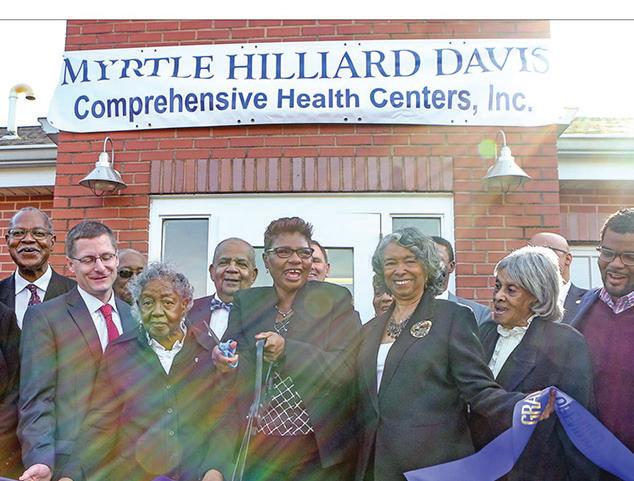


a picture of a building in the newspaper and of jobs people who work in that building could have.
Types of News: Use the front section of the newspaper to evaluate the types of news stories presented: local, national, and international. Sort the articles into the three categories and create a bar graph that displays the amount of coverage each type
Activities — Who works where? a picture of a building in the




Mystery Story: Cut out several pictures from the newspaper without reading the caption. Place the pictures in a bag, and without looking, pick your mystery picture from the bag. That’s your stimulus for writing. Construct a graphic organizer to identify the 5Ws (who, what, when, where, and why) of your story by looking at your picture. Then, continue the writing process.
Problem and Solution: Over a period of weeks, clip articles from newspapers that deal with problems and issues facing your local or county government. Discuss the reasons for these problems and how the government hopes to solve them.
of jobs people who work in that building could have.
Problem and Solution: Over a period of weeks, clip articles from newspapers that deal with problems and issues facing your local or county government. Discuss the reasons for these problems and how the government hopes to solve them.
Learning Standards: I can use the newspaper to locate information. I can discuss problems and solutions. I can identify types of jobs. I can make text-to-world connections.
Learning Standards: I can use the newspaper to locate information. I can categorize and summarize that information.
Learning Standards: I can use the newspaper to locate information. I can discuss problems and solutions. I can identify types of jobs. I can make text-to-world connections.








Aariyah Thompson and Savannah Fisher, in Ms. Stovall’s firstgrade class at Gateway MST Elementary School, are learning how to construct a series circuit.
Photo by Ms. Stovall
Students Aariyah Thompson and Savannah Fisher, in Ms. Stovall’s firstgrade class at Gateway MST Elementary School, are learning how to construct a series circuit.
Photo by Ms. Stovall

Rihanna and A$AP Rocky welcome baby girl
Music star and beauty mogul
Rihanna revealed on social media that she and partner A$AP Rocky recently welcomed a baby girl.
Rihanna shared their daughter’s name, Rocki Irish Mayers, and debuted the first image of her newborn on Wednesday.
The photo, posted to her various social media channels, showed the 37-year-old artist and Fenty Beauty founder holding her daughter. Rocki is Rihanna’s third child with rapper A$AP Rocky, whose real name is Rakim Mayers. According to Rihanna’s Instagram page, Rocki was born on September 13. pair also share three-year-old RZA Athelston Mayers
two-year-old Riot Rose Mayers
Another image Rihanna shared Wednesday showed two small pink boxing gloves with
long pink ribbons. The couple’s red carpet appearance at the Met Gala in May served as the pregnancy announcement for their third child.
Ice Cube’s tour bus set ablaze
Ice Cube and his touring crew are safe after a fire occurred on the exterior of his tour bus in Portland earlier this week.
The incident occurred after the rapper and movie star stopped at the Moda Center for a performance on Monday, according to KOIN.com.
Portland Fire and Rescue confirmed that on Tuesday, the front passenger tire of a charter bus caught fire near Southwest Oak Street and Southwest Broadway.
“We extinguished the fire and used a fan to ventilate the smoke from the bus,” said a spokesperson for Portland Fire & Rescue. He added that the cause of the fire is under investigation and that he was not aware of who was using the bus.

“I’m not taking this incident as a personal attack,” Ice Cube said in a statement. “A coward like that would burn anybody’s property that was out there at the time.”
Group connected to Nas gets preliminary nod for Queens casino bid
A bid to build a casino at Aqueduct Resorts World in Queens supported by Nas took a step forward Thursday — just days after a Jay-Z affiliated group was denied.
According to the New York Post, Aqueduct won a preliminary approval from a state sitting board to move onto the next stage to receive one of up to three casino licenses. A Caesars Times Square bid by Jay-Z was flatly rejected last week.
Nas is a partner in the Genting Resorts World bid for a state gaming license to offer live table games such as craps, blackjack and poker. The $5 billion proposal includes a concert hall and a sports academy involving Queens hoops legend Kenny “The Jet” Smith.
Hernandez — the 15-year-old girl who was found dead inside a Tesla linked to musician D4vd — had been in the car for several weeks before it was discovered.
“The Los Angeles County Medical Examiner has not determined a cause or manner of her death, so we don’t know for sure if anyone has any criminal culpability for her death beyond the concealment of her dead body,” a spokesman for the LAPD’s robbery-homicide division said, according to PEOPLE. The division told the celebrity news and entertainment outlet that the department is still probing the case.

Nas
Body of Celeste Rivas Hernandez believed to have been in car for weeks
The Los Angeles Police Department believes that the body of Celeste Rivas
The LAPD would not confirm to PEOPLE that d4vd was cooperating with the investigation, despite a statement his rep made to NBC Los Angeles that the “Romantic Homicide” singer was “fully cooperating with the authorities.”
D4vd has not been named a suspect or charged with a crime in relation to the case.
Sources: PEOPLE.com, NYPost.com, KOIN.com, Instagram.com, TMZ.com


















Ice Cube
subject to city regulation.
Mason told The American he was stunned by the board’s actions and plans to ask a judge to block the measure.
“What the board is essentially saying is they can take control of the financial monitoring of any independently elected county officer, assessor and so on … that they can add duties to those officers that are not in any statue,” Mason said, adding, “and to make it worse, they think they have the power to put anyone of these elected officials on probation. Are you kidding me? The bill, on its face, is absolutely silly.”
Alderwoman Sharon Tyus was the only member to oppose the measure, saying the board has no authority to impose duties
on county-level elected officials. “We don’t have the ability to put in a board bill that the state statute provides something when it doesn’t,” she told St. Louis Public Radio. Montgomery already is facing a legal challenge. In June, former state Attorney General Andrew Bailey filed a 90-page lawsuit alleging that Montgomery engaged in illegal arrests, misused the sheriff’s office for personal gain, practiced nepotism and mismanaged funds. The type of suit Bailey filed questions whether someone is legally entitled to hold office; such suits traditionally are not used to address alleged misconduct.
Mason argues the board and Democratic Mayor Cara Spencer are compounding the problem by acting on unproven allegations made by a Republican official.
“Instead of waiting to see how the [lawsuit] plays out, the board has gotten it
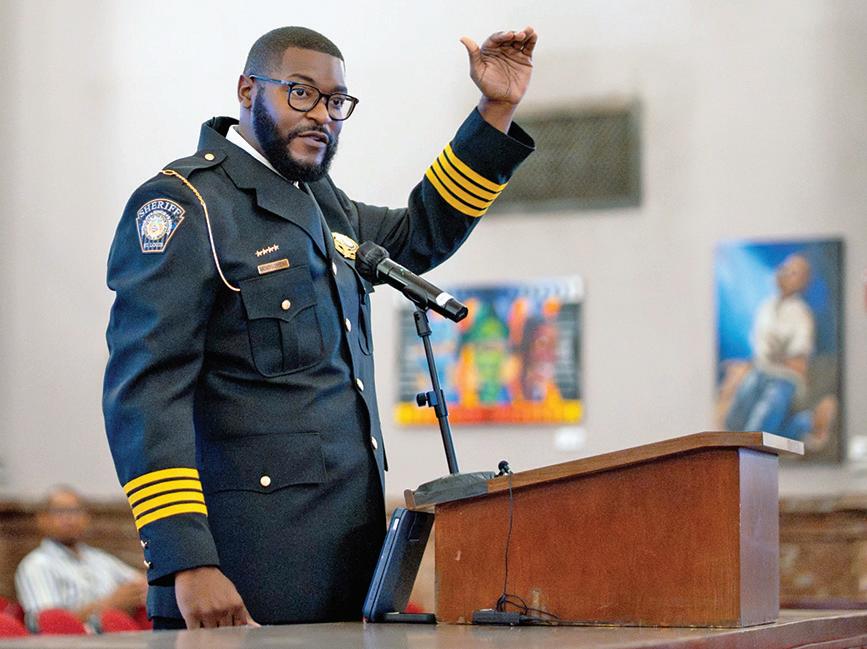
into their heads that they have to write a bill to create that duty,” Mason said. “Why? Well, it’s because they know that [the suit] has a real chance of going down on this issue.”

Although the bench trial in Circuit Court has been set for Nov. 10, Mason already has challenged several of Bailey’s claims, such as the nepotism charge, the claim that he ordered his deputies to pick his children up from school and if it’s his office or the city’s responsibility to transport detainees to hospitals.
Mason said federal courts have long held that the responsibility for inmate healthcare falls on the entity with “care, custody and control of the prisoner,” not the one that transports them. In his view, that makes the city — not the sheriff’s office — responsible for transporting detainees to hospitals for medical treatment.
Spencer and other city officials argue Montgomery is breaking with precedent. They note
Tornado
Continued from A1
repairs and updates to empty rental units. Funded with Rams Settlement dollars, the

that the two previous sheriffs handled detainee transport.
“Should Mayor Spencer be held accountable for what other mayors have done in the past? No,” Mason said. “Just because a sheriff has done it for a while or has been willing to do it doesn’t mean anything if the board isn’t willing to finance it.”
Montgomery’s request for extra funding to cover medical transport, however, was denied by the budget committee amid questions over his office’s spending.
Alderman Rasheen Aldridge said he disagreed with the provision assigning medical transport duties to the sheriff’s office, but he still supported the overall bill.
“When you are making almost a mockery out of an office and having a
initiative will provide up to $10,000 per unit to ensure families have safe housing before the end of 2025. The application deadline is Oct. 31 at 4 p.m., or until all funds are obligated.
“The May 16 tornado left thousands of St. Louis families without safe, stable housing,” Mayor Cara Spencer said. “This program puts our resources to work, turning vacant units into homes for families who need them most. By working with community partners and developers, we can ensure recovery dollars translate directly into housing security and stability for residents.”
Applications opened Sep. 26 and will be reviewed on a rolling basis until funds are exhausted.
Officials emphasized the importance of early submissions to meet the Dec. 31 deadline for occupancy.
The tornado damaged more than 10,000 homes and buildings.
St. Louis Sheriff Alfred Montgomery speaks at a Board of Aldermen Budget and Public Employees Committee hearing in June. The city has moved to redefine his duties and impose stricter oversight of his spending.
lot of situations that happen, you got to be real,” Aldridge told St. Louis Public Radio. “Regardless of what department you’re in, this Board of Aldermen is serious about transparency, accountability and making sure that government runs as efficient as possible.” Mason maintains the board is acting prematurely and unfairly.
“They literally want the sheriff to report on everything he’s spending like he’s a kid — something they haven’t done with any other independently elected county official,” Mason said. “So, they disagree with how the money is spent … so what? Take it to the people, and let them decide at the polls.”
Sylvester Brown Jr. is the Deaconess Foundation Community Advocacy Fellow.
affordable housing units citywide with over $100 million in awards.
“Many of our community development partners are caught in a vicious cycle: Empty units mean less income, deferred maintenance and more vacancies,” Fefer said. “In the wake of the tornado, the need is greater than ever, so we’re scaling the program with Rams funds in order to house displaced families while stabilizing distressed portfolios.”
Funding is open to nonprofit developers, community development corporations, and public entities that own rental portfolios. For-profit landlords are not eligible. Properties must be within the city limits and leased exclusively to families displaced by the tornado, working in partnership with case management agencies.
“This program puts our resources to work, turning vacant units into homes for families who need them most.”
– Mayor Cara Spencer
“The damage from the tornado is overwhelming,” said Tom Nagel, a spokesman for the city’s Community Development Administration (CDA). Some of the vacant units may need repairs ranging from plumbing to HVAC systems to new windows, he said. “This is the quickest way to get available housing to those impacted by the tornado quickly.” Nagel said the grant funds are targeted toward community development corporations, nonprofit landlords and home builders because they have a track record of building quality housing and using the funds quickly and effectively.
CDA Executive Director Nahuel Fefer said the initiative builds on a pilot program launched last year to address the cycle of vacancies and deferred maintenance in rental properties. Since 2020, CDA has helped fund more than 3,500
Linda Nguyen, executive director of the Community Builders Network, said the initiative will give families a place to call home within months rather than years. Because the program focuses on non-structural, minor repairs, many vacant properties could be ready by winter.
“It’s a good start to address immediate housing,” Nguyen said. “A lot of our nonprofits already own some of these houses, but they don’t have the funds to address the needs.” Nguyen estimates the program could bring 200 to 300 two- and three-bedroom units back online. Still, she noted, the city ultimately will need hundreds of millions of dollars to fully tackle its broader vacancy challenges and ensure long-term recovery for families affected by the storm.
A public hearing and informational workshop will be held on Oct. 7, from 10 a.m. to noon, and applications will be accepted through CDA’s grants portal.
Photo by Brian Munoz / St. Louis Public Radio
RBC partners with St. Louis schools to improve fiscal practices
Action follows scathing state audit
St. Louis American staff
The St. Louis Regional Business Council has partnered with St. Louis Public Schools to address findings from a recent state audit, and district administrators recently met with the Missouri Department of Elementary and Secondary Education to present an action plan.
According to school officials, the plan addresses the audit findings and outlines a structured framework for improving fiscal practices.
Key areas include budget planning, strategic forecasting, procurement, internal controls, and payroll compliance. The district already has adopted new financial policies and is working daily to reinforce controls “to ensure sound financial management,” according to the district.
Superintendent Dr. Millicent Borishade said the “path to strong compliance readiness requires us to be policy-driven.” She said the district has begun
the process.
“We know that means revising outdated policies and eliminating old practices, which we’ve been doing,” she said.
Dr. Karen Collins Adams, school board president, said the district is considering how RBC can provide backing to help meet mutual goals. She said such collaborations are needed to foster a strong educational environment for students.
“The board’s role is to ensure that policies serve as the guide and framework for decisions made that will ultimately benefit every student, staff member and family in our district,” she said.
The state audit released in August showed:
• The district paid about $3.5 million in attendance incentives in violation of the Missouri Constitution, including payments made to non-union employees without advance agreements and to skilled trades employees outside the scope of a legal contract.
• A review of 27 credit
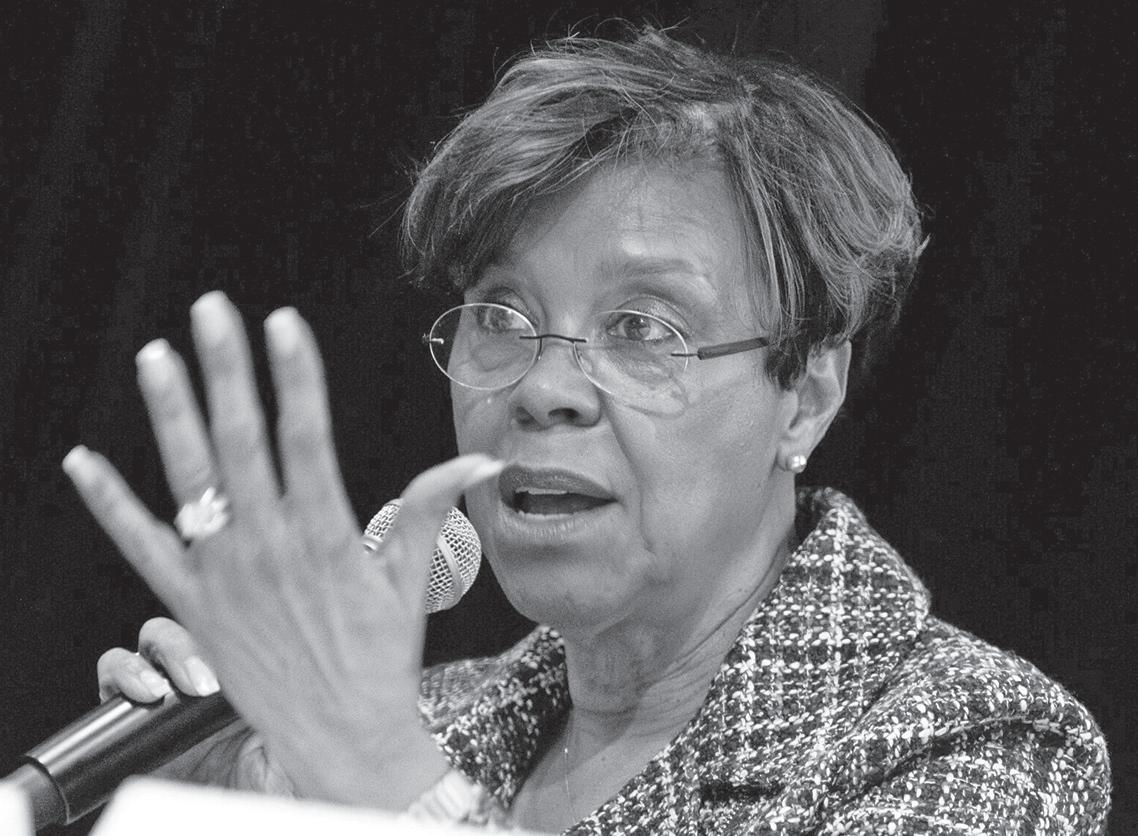
card transactions found that 17 of them — totaling $12,436 — were “questionable and/or unreasonable,” including $3,888 for a Top Golf event, $1,689 for a four-night stay at Caesars Palace in Las Vegas and $1,282 for an
Airbnb rental charged to the former superintendent’s district-issued card.
• The district paid $1,106 in late credit card fees and allowed excessive credit limits — including a $450,000
limit on one card that saw minimal use — without regular review. The audit also found that from fiscal year 2024 to 2026, the district is projected to spend $86.5 million more than it brings in, based on budget doc-
Collins-
Schools board president, said the district is exploring opportunities for the St. Louis Regional Business Council to assist with the district’s fiscal crisis. A state audit released in August concluded the district “faces a rapidly deteriorating financial condition.”
uments provided to state officials.
Missouri State Auditor Scott Fitzpatrick said the district’s finances are rapidly worsening because the board failed to adequately prepare for the future.
Ron Kitchens named Greater St. Louis Inc. CEO after national search
Greater St. Louis Inc., has named Ron Kitchens as its new CEO.
He was serving as president and CEO of the Wichita Falls, Texas, Chamber of Commerce and Industry. He has more than three decades of economic development experience working with organizations in Michigan,
Symphony
Continued from A1
“We celebrate being back home, together,” added St. Louis Symphony Orchestra President and CEO Marie-Hélène Bernard as she welcomed guests to the media preview. The upgrade honors the hall’s storied past while opening its doors to a broader future.
As night fell, the vision of the reimagined hall became crystal clear. Guests arriving for the St. Louis Symphony Orchestra’s 146th season became the first to experience the multimillion-dollar redesign by world-renowned firm Snøhetta.
Formal gowns and tuxedos mingled with blue jeans, T-shirts and wellworn sneakers as crowds made their way toward the new entryway on Saturday.
Williams
Continued from A1
into the classroom, where she now shows students that their ZIP code does not define their future.
“My skin looks like them. My dialect — I sound like them as well. But I also foster a sense of hope,” she said.
Williams, now assistant school leader at Momentum Academy in Tower Grove, is being recognized for her deep commitment to children. She is one of five Excellence in Education honorees who will be celebrated at the Salute to Excellence in Education Scholarship and Awards Gala, sponsored by the St. Louis American
Texas, Alabama and Missouri.
Kitchens is a graduate of Missouri State University and worked as a staffer for former U.S. Sen. John Danforth.
“Over the course of my career, I have had the honor of helping communities rediscover hope, reignite growth,
Light from the music center’s massive windows made the building appear as much a beacon of light as it is a building that’s home to the nation’s second-oldest symphony.
“This new hall and music center, which is so open to the outside with its gorgeous windows and the stairs going up … is the way to help people feel that they belong,” said SLSO Music Director Stéphane Denève. “That it is home for them too.”
That feeling permeated through the space in a series of events leading up to the opening weekend — including the grandscale ribbon cutting the week before the public had access to the space.
“This region owes you a debt that it can never repay,” a passerby said to Andrew C. Taylor. After taking in the grand new staircase in the building named after Taylor’s
Foundation, on Nov. 1. Her dream of becoming an educator began on the steps of her grandmother’s home in Walnut Park. At age 5, she fell in love with teaching while playing school with her cousins. It was there she also first played the role of an administrator, acting as the family’s school principal in their childhood game.
As the aspiring educator grew older, school became tougher than expected after her father pulled her out of Normandy High School. Her move to Gateway Christian High, a private school, proved to be an academic culture shock.
“I went from an A-B student to a C-D student at Gateway Christian,”
and reimagine what is possible,” Kitchens said.
“St. Louis is near and dear to my heart, and I am excited to play a role in building a prosperous future for this region.”
Kitchens will begin working at GSL in early November. Dustin Allison, the company’s chief real estate invest-
father, the guest made sure to thank Andrew Taylor personally.
“This city doesn’t owe me a thing,” Taylor said as he shook the person’s hand. “It has been a privilege and an honor to support this wonderful orchestra — and this amazing community.”
Being a St. Louis Symphony benefactor has become as synonymous with the Taylor name as Enterprise Holdings — the company Andrew Taylor’s father, Jack Taylor, founded nearly 70 years ago. As the business expanded, so too did the family’s support for SLSO over the decades.
With the Jack C. Taylor Music Center, SLSO now has the venue that its talent and reputation deserve.
“It exceeded our expectations. We are really delighted with the way it came out,” said Anna Leavey, who served as
Williams said. “So, I had no choice but to be engulfed in education. My dad promoted school, and my mom taught us survival.”
Williams’ determination paid off. Her fight to rise above failure led her to receive degrees from St. Louis Community College, Central Methodist University and the University of Missouri-St. Louis. Colleagues say what sets her apart is the attention and care she gives to children who have a troubled home life and struggle in school. Momentum Academy school leader Christian Jude said Williams inspires staff and students “to not let anything be a barrier but to use that as a launchpad to
ment officer, has served as interim CEO since December 2024.
“We are thrilled to welcome Ron back to Missouri and look forward to the impact he will have on the St. Louis region,” said Andrew C. Taylor, executive chair of Enterprise Mobility and founding chair of GSL.
project manager for the expansion.
The upgrades and additions to Powell Hall, which has been SLSO’s home since 1968, took ten years of planning and two years of construction.
“It has been such a team effort. We are happy to now be able to share it with everyone,” Leavey said. “This is one of the special projects that I’ve worked on, and I’m really excited to share it with students, people in the St. Louis and the region.”
Her sentiment was echoed by Craig Dykers, a founding partner of Snøhetta and lead architect for the 64,000-square-foot expansion.
“I love to see people’s faces as they walk up to this magnificent expansion,” Dykers said. “But then there is also the joy when they see the renovations inside Powell Hall. They see we hav-
be successful.” Williams was inspired to go into education by her son, who learned differently than other kids and was suspected by his kindergarten teacher of having a developmental delay. Her son had no learning disabilities, but Williams was motivated to better understand children who do. She began taking early education classes, advancing in her studies as her son advanced in his. While Williams was a teacher at KIPP St. Louis, her then-school leader, Justin Schulze, assigned her to a classroom of students with low grades and poor behavior. Looking back, Schulze said she transformed the class so quickly that it seemed like magic.
“Ron is a proven leader who has the strategic vision, operational expertise and deep passion required to lead Greater St. Louis Inc. into our next chapter.”
Since being established in 2021, GSL has focused on:
• Attracting new investment and growing
en’t changed that much, and we’ve really just improved.”
Denève loves the flow of the space. A few steps from the contemporary feel of the music center with its winding concrete staircase and floor-to-ceiling windows, are all the classic elements of Powell Hall.
“It really reconciled the old with the new,” Denève said. “For me, it is spectacularly well made. You have the feeling that whatever your age, whatever your style, you will feel at home here.”
He also praised the upgrades to the historically inaccessible concert hall. “This place has to be accessible because of the true message that what we do is for everybody,” Denève said.
But for him, that goes beyond providing much-needed upgrades so that patrons with a wide
“She just brings a certain type of energy that makes kids want to pay attention to what she is saying and doing,” Schulze said. “Twenty years from now, those kids will look back and say, ‘Ms. Williams made me feel seen and heard.’” At Momentum Academy, Executive Director Liz Valerio said Williams “walks with that aura” of seriousness about educating students. “I respect that so much,” Valerio said.
As Williams prepares to accept her Salute to Excellence award next month, she carries the memory of two loved ones who left too soon: a brother murdered in Walnut Park in 2018 and a sister who died of AIDS when
jobs and population across the 15-county bi-state St. Louis region.
• Supporting the transformation of St. Louis Lambert International Airport into a world-class destination.
• Revitalizing downtown into a thriving, vibrant and safe area.
spectrum of abilities can attend with greater ease. He feels that the upgrades come with an instant sense of belonging.
“I’m always very sad when people seem to be a bit worried or intimidated,” Denève said. “We love something, which is music, and we want to offer it to you. And we want to do everything we can to make sure you feel at ease to receive it.”
For Dykers, having a role reimagining SLSO’s new home deepened his connection to the city.
“There is no place like St. Louis anywhere else in the world,” Dykers said. “And everyone knows St. Louis and have a particular love for the city — even if they’ve never been here. I was one of those people. Being a part of this project is special because of that — and I don’t get that feeling in every city.”
Williams was 19.
“My sister and brother will be cheering me on. My brother would say, ‘I knew it,’” she said. Jude, who also grew up in north St. Louis, sees Williams’ recognition as proof of what’s possible. “It shows you don’t have to move away to make an impact,” he said. “We can still help St. Louis babies become awesome people and to do awesome things in this world.” Williams hopes her students will carry that same lesson — that anything is possible — as her legacy. “They just have to believe in themselves,” Williams said. “If I was able to obtain it, there is no doubt in my mind others can.”
Photo courtesy of St. Louis Public Radio
Karen
Adams, St. Louis Public


Living It
“I’ve learned so much, and I just wanted to share that with other parents who just don’t know where to turn.”
- Faith Evans on raising a son with Autism and becoming an advocate for Autism awareness.
SLSO returns to Powell Hall
146th season begins with two world premieres and a banger by Strauss
By Chris King For The St. Louis American
The St. Louis Symphony Orchestra opened its return to the renovated Powell Hall, housed within the brand new Jack C. Taylor Music Center, with three fanfares and two commissioned world premieres. If that sounds like making a lot of noise, then you should have heard it inside the concert hall. After two seasons of performances at the Touhill Performing Arts Center and the Stifel Theatre, it was startling to be reminded what a loud room this is (and the renovation may have made it more so). And these fanfares, dominated by brass and percussion, were loud pieces. This was live, loud music.
The first commissioned world premiere was the last of the three fanfares: Fanfare for Universal Hope by James Lee III (born in 1975). He is a go-to composer for musical director Stéphane Denève, and one of the most accomplished contemporary Black composers. Judging by the premiere performance, percussionists have the most to hope for in this universe, as this four-minute blast is a dream for musicians who hit things rhythmically with sticks. A gong, in particular, played in resonant counterpoint to the strings as the orchestra drove to the conclusion, at which point Lee joined Denève and the band onstage to celebrate the premiere and its occasion.
The first sounds that rang publicly in the newly restored space was Fanfare for the Common Man by Aaron Copland (1900-1990). It’s like Copland



said, “Hold the strings and winds,” writing only for percussion (big bass drum, gong, timpani) and enough brass players to field a football offense plus a kicker and punter. There were enough brass players (15) to field a football defense, too, but nobody was playing defense: this was big, brash, molar-crunch ing music on the attack.
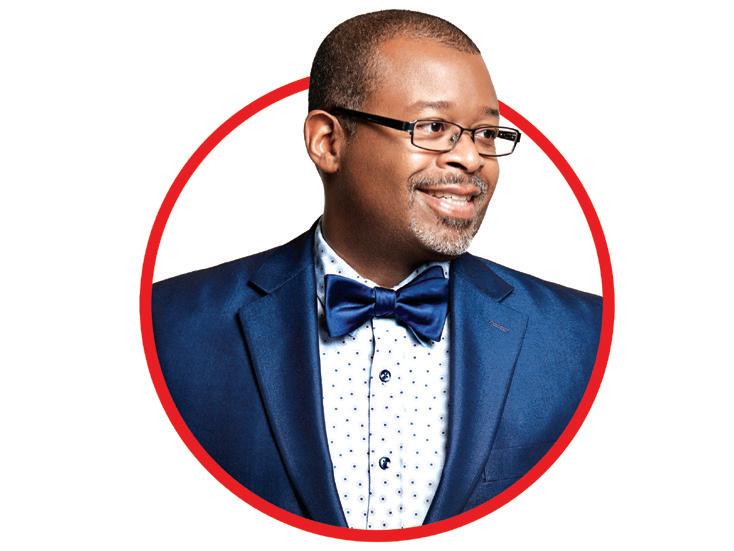
In between the two, the orchestra played Fanfare for the Uncommon Woman No. 1 by Joan Tower (born in 1938). Neither as bombastic as Copland nor as idiosyncratic as Lee, Tower’s piece (also for mostly percussion and brass) slipped somewhat between the cracks of the fanfare med-
Bridge to Bridge: Golden Gate to Frederick Douglass

Wyoming, we spotted this Texaco station frozen in time. From the pumps to the gas delivery truck, it was a visual treat.
By Michael Dutton and Fred Sweets
“Get your kicks on Route 66.”
Nat King Cole recorded that little ditty three times, in 1946, 1956 and 1961, and performed it hundreds of times. The song romanticized the lure of the road, to visit far-flung places from Chicago to Los Angeles and St. Louis was a stop along the way. Post-World War II prosperity and the growth of automobile ownership made the trip appealing. Recently, St. Louis American Con-

tributing Editor Fred Sweets set off on one of his cross-country treks, traveling east from Tiburon, California, north of San Francisco, to Washington, DC. He convinced his old friend Michael Dutton to fly to California from DC to accompany him.
Starting at dinner with Publisher Donald Suggs and artist Oliver Jackson at film director Francis Ford Coppola’s restaurant Café Zoetrope, in San Francisco’s famed Jackson Square district. Preparations were made for a Labor
ley. I found myself looking around and noticing details like Denève was more tightly barbered than usual. He did not have enough mane to have his locks go rogue in the air as he whipped
The second commissioned world premiere was House of Tomorrow by Kevin (born in 1972 in a little river city called St. Louis). This was a choral piece (written for Joyce DiDonato, mezzo-soprano) that enabled the St. Louis Symphony Chorus (directed by Erin Freeman) to share in the reopening festivities. After the fireworks of the fanfares, it was good to hear silky strings and plaintive woodwinds, now audible,
fill the concert hall. Being able to hear the entire orchestra playing all together as an ensemble served as a second opening of the concert and season.
House of Tomorrow is a medley of five songs with a book adapted by the composer from The Prophet by Kahlil Gibran (1883-1931). The language, projected above the stage, was so powerful it shaped my experience of the music. “The deeper that sorrow carves into your being,” the chorus sang, “the more joy you can contain.” I thought that, given the sorrow and terror and dread of America in 2025, our capacity for joy must really be expanding. I was struck that the most peaceful and pastoral piece, “Of Work,”
‘Everybody has art in them’
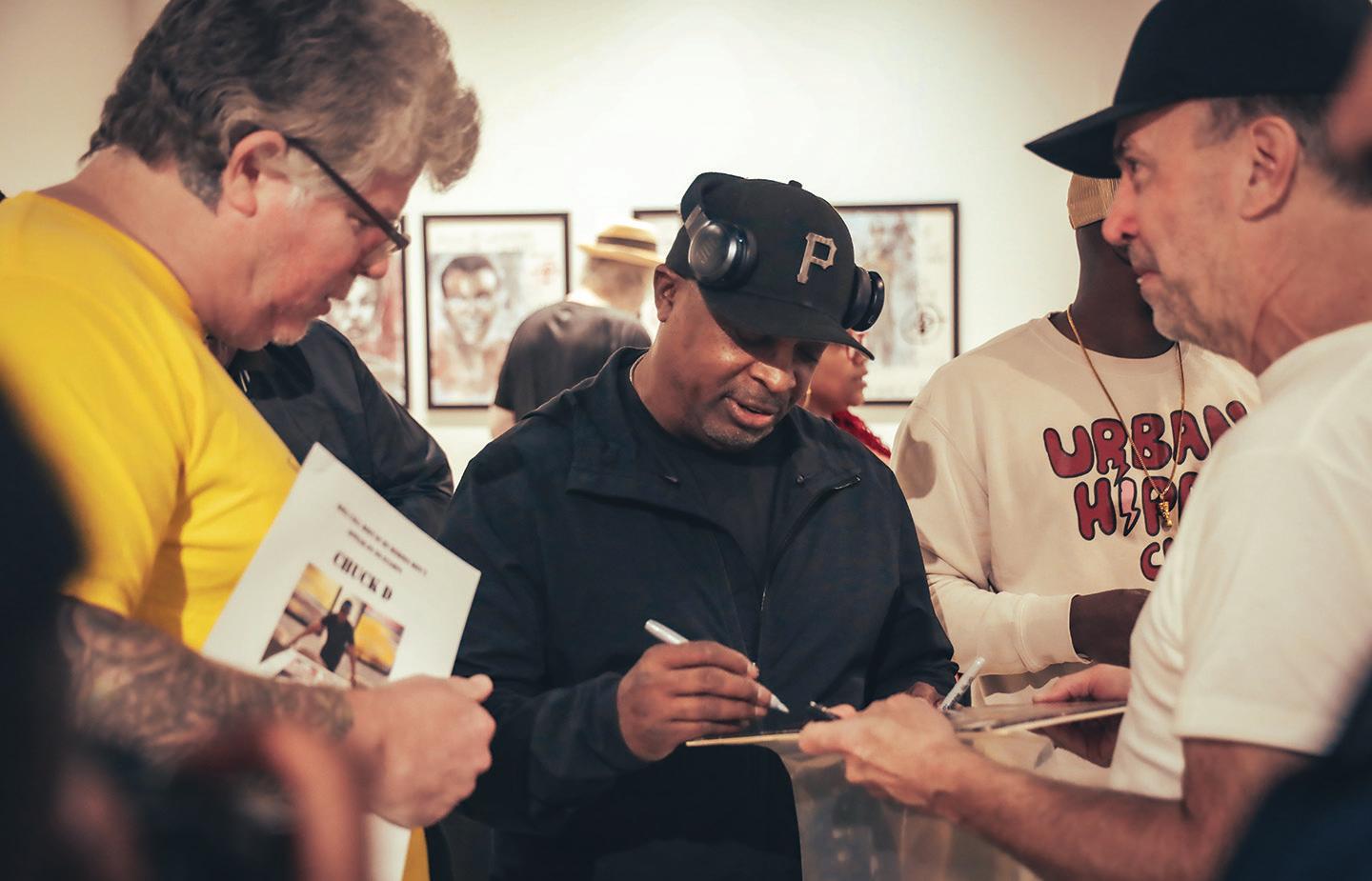
Rap
icon Chuck D
discusses
his
work and process at Legends gallery talk
By Kenya Vaughn St. Louis American
When Chuck D fellowshipped with guests and discussed his creative process at Legends Gallery on Friday night and Saturday afternoon, he wasn’t engaging with them as a hip hop pioneer and legend. He was an emerging artist with his first Midwest solo exhibition eager to share his creative process.
“Being here in St. Louis is a joy,” Chuck D told the intimate, invite-only crowd. They filled every seat and lined the walls of the boutique gallery in the heart of the Grand Center Arts District.
“So is being in a gallery and a part of the activity that is going on here in the community,” he said. “I’m an artivist
and a raptivist and my religion and my service is the arts.”
His talk took place just a few hours before he took the stage as frontman for the iconic hip hop group Public Enemy in Forest Park. They were one of the headliners for Evolution Festival 2025. The day before he gave his undivided attention in conversations about “Roll Call: Most of My Heroes Don’t Appear on No Stamps,” which will be on display through November 12.
The title of the show is a direct rip from one of his most famous lines in his most famous songs. “Fight The Power.” And while some of the artist portraits in fact appear on stamps –including Nina Simone – each artist has
St. Louis American
Photo by Fred Sweets /St. Louis American
In Rawlins,
Photos by Taylor Marrie/St. Louis American
pioneer and emerging artist Chuck
shared his evolution from emcee to artist at a special gallery talk at Legends on Saturday, September 27.
See SLSO, B2
Photos by Taylor Marrie / St. Louis American
Guests who attended the opening weekend of the St. Louis Symphony Orchestra’s 146th season were instantly greeted by the stunning architecture of the all-new Jack C. Taylor Music Center, which now houses the beautifully renovated Powell Symphony Hall. (Top right) Eric Dundon, Director of Public Relations for the St. Louis Symphony Orchestra, with St. Louis Argus publisher Talibdin “TD” El-Amin and Dr. Safiyyah El-Amin during a media tour of the new Jack C. Taylor Music Center on Wednesday, September 24.
James Lee III
CONCERTS
Wed., Oct. 8, 6:30 p.m. doors, Do the Reggae Tour staring Ziggy Marley and Burning Spear, The Factory at The District, 17105 North Outer 40 Road, Chesterfield, MO 63005. For more information, visit www.thefactorystl.com.
Fri., Oct. 17, 7 p.m. St. Louis Symphony Orchestra Presents Chuck Berry’s Birthday Bash, Powell Hall, 718 N Grand Blvd, St. Louis, MO 63103. For more information visit https:// shop.slso.org.
Fri., Oct. 24, 7 p.m. doors, The Factory at The District welcomes T-Pain, The Factory at The District, 17105 North Outer 40 Road, Chesterfield, MO 63005. For more information, visit www.thefactorystl.com.
Sat., Oct. 25, 7 p.m., Playboi Carti Antagonist 2.0 Tour, Enterprise Center. For more information, visit www.livenation.com.
Sat., Nov 22, 8 p.m. (RESCHEDULED) Sexyy Red and Friends, Enterprise Center, 1401 Clark Ave, St. Louis, MO 63106. All previous tickets will be honored. For more information, visit /www.enterprisecenter. com.
SPECIAL EVENTS
Sat., Oct. 4, 10 a.m.
Zootoberfest, St. Louis Zoo, 1 Government Drive, St. Louis, MO 63110. Various start times. For more information, visit https://stlzoo.org.
Fri., Oct. 17, 7 p.m. St. Louis Symphony Orchestra Presents
ART
Continued from B1
contributed to fighting the powers that be through their art, their activism or both.
“Artists are the gatekeepers of truth” is written across a portrait of a young Harry Belafonte. The quote belongs to Belafonte. The mixed medium image with water colors that has Belafonte song titles written in all capital letters is a Chuck D original.
“I go off of whatever hits my vibe,” Chuck D said. “Eighty percent of the time, I work from head arrangements. That means I work outside my head. I don’t work from photos.”
He appeared to receive creative nourishment as those who attended shared their impression of his art. When the conversation drifted to his music, he didn’t shy away or implementing harsh boundaries.
His hip hop journey is what led him to becoming a prolific artist. Like so many other touring artists, he would be on the road
Continued from B1
St. Louis American Calendar
STL Sites & Sounds
Chuck Berry’s Birthday Bash, Powell Hall, 718 N Grand Blvd, St. Louis, MO 63103. For more information visit https://shop. slso.org.
Sat., Nov. 1, 6 p.m. (5 p.m. reception) The St. Louis American Foundation presents the 38th Annual Salute to Excellence in Education Scholarship and Awards Gala America’s Center. For more information, visit www.stlamerican.com.
COMEDY
Sat., Oct. 4 - 5, various showtimes, Special Event: DC Youngfly, Helium Comedy Club, 11151 St. Louis Galleria Street, St. Louis, MO 63117. For more information, visit https://st-louis.heliumcomedy. com.
Sat., Oct, 11, 8:30 p.m. (doors), Ryan Davis from TV shows like Issa Rae’s “Insecure,” City Winery St. Louis, 3730 Foundry Way, St. Louis, MO 63110. For more information visit https:// citywinery.com.
Sun., Oct. 12, 6 p.m. Special Event: Nicole Byer, Helium Comedy Club, 11151 St. Louis Galleria Street, St. Louis, MO 63117. For more information, visit https://st-louis-heliumcomedy-com..
ST. LOUIS MUSIC SPOTLIGHT
Sat., Oct. 4, 7 p.m. (6 p.m. doors), A tribute to Luther Vandross and Frankie Beverly
for long stretches with absolutely nothing to do during the downtime.
“The show is only an hour,” Chuck D said. “You’ve got 23 other hours.”
He learned that Ron Wood of The Rolling Stones would sketch in his hotel room and whatever was happening outside of the window.
“When I heard he did that, I was like ‘ding,’” Chuck D said.
By the time he was touring as part of the band Prophets of Rage, he was turning his hotel room into an art studio.
“I would just churn out and churn out,” Chuck D said. “While everybody might get bored in the city, I’m just churning out.”
He called his process rudimentary.
“People say, ‘Oh, I use this and I use that.’ I don’t have no idea of what I’m doing,” he said. “I can use spit. These were done with white out sharpies, pencils, anything I can get my hands on,” Chuck D said. He pointed to the pieces of art behind him. Belafonte and Simone’s portraits were on that row.
was the work song. Redeeming sorrow and ennobling work – these felt like relevant messages to send out into a damaged world in much need of repair. The concert closed with A Hero’s Life, an epic tone poem in six movements by Richard Strauss (18641949). This performance was a feast of textured, articulated, responsive and resonant ensemble musicianship. Strauss nurtured ensemble playing by writ-
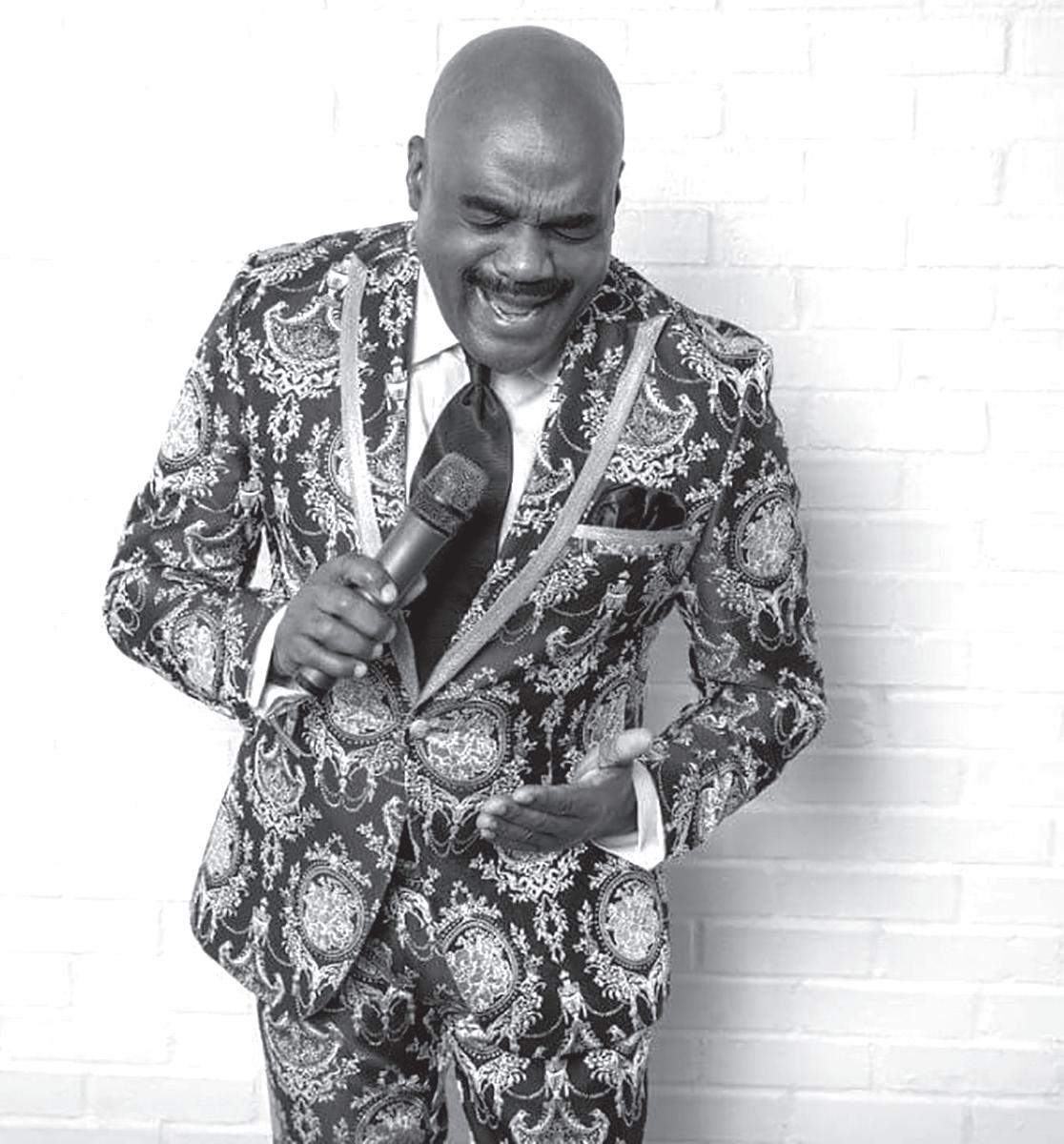
starring national recording artist and St. Louis native Julius Williams and musical director Timothy “TC” Chandler. Grandel Theatre, 3610 Grandel Square. For more information, visit www.metrotix.com or call 314.534.1111.
Through Oct. 5, Mary Stallings with Jazz St. Louis, Steward Center, 3536 Washington Avenue, St. Louis, MO 63103. For more information, visit https://my.jazzstl.org.
Sun., Oct. 5, 7 p.m. A Neo Soul Love: Tribute to Erykah Badu & Jill Scott, City Winery
St. Louis, 3730 Foundry Way, St. Louis, MO 63110. For more information, visit https://citywinery.com.
Wed., Oct. 15, 7:30 p.m. The Best of Marvin Gaye and Smokey Robinson with Nostalgia and The Motown Band, The Blue Strawberry, 364 N. Boyle Ave, St. Louis, MO 63108. For more information, visit https://bluestrawberrystl. com.
THEATRE
Fri., Oct. 3 - 11, 7:30 p.m. It
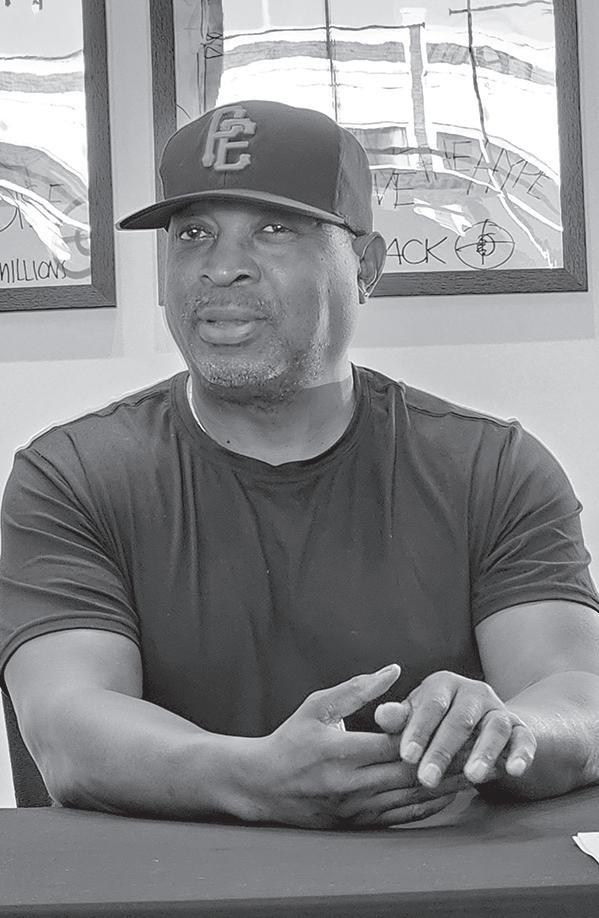
Despite declaring himself an amateur as far as a maker, his connection to
ing so many tasty features for so many instruments. The orchestra pulsed with Strauss’ love for individual instruments and his generosity toward musicians. The players danced in their seats and with their instruments. Denève flourished an entire 180-degree arc in cueing all the features.

art and his depth of knowledge regarding the power of art was profound and
One musician, however, stood out, though she stayed seated: Erin Schreiber, assistant concertmaster, took the violin solos, which at times were so clustered it was difficult to understand why she was not standing in a soloist’s spotlight. I would be hard-pressed to name an emotion she and Strauss did not wring from those four strings. Denève was so transported at one point he sawed his baton like her fiddle bow. The conductor, in essence, played air violin. One musical surprise, to me, was the screechy, edgy, upper-register playing I associate with more experimental contemporary music. The creative
Shoulda Been You, Johnson Hall at Third Baptist Church, 620 N Grand Blvd, St. Louis, MO 63103. For more information visit https://www.taketwoproductions.org.
Fri., Oct. 10 – Sun., Oct. 13, Union Avenue Opera One-Act Festival featuring dwb (driving while Black), Union Avenue Opera, 733 N. Union Blvd, St. Louis, MO 63108. For more information, visit www.unionavenueopera.org Through Oct. 25, New Line Theatre presents Bat Boy, a musical-horror-comedy, Marcelle Theatre, 3310 Samuel Shepard Dr. St. Louis, MO 63103. For more information, visit www.newlinetheatre.com.
ART
Through June 2026, The Future Is Female, 21c Hotel and Museum Hotel St. Louis, 1528 Locust St, St. Louis, MO 63103. For more information, visit https://21cmuseumhotels. com.
Through February 1, 2026, Jennie C. Jones: A Line When Broken Begins Again, Pulitzer Arts Foundation and Museum, 3716 Washington Blvd, St. Louis, MO 63108. For more information, visit https://pulitzerarts.org.
Through February 8, 20‘26, Teresa Baker: Somewhere Between Earth and Sky, Contemporary Art Museum, 3750 Washington Blvd, St. Louis, MO 63108. For more information visit, https://camstl. org.
“Art can be an extension of yourself – and your saving grace. You don’t make your art for somebody else. You make your art for you. Everybody has art in them. But it is not so easy to get it out of them.”
-Chuck D
insightful. “Art can be an extension of yourself – and your saving grace,” Chuck D said. “You don’t make your art for somebody else. You make your art for you. Everybody has art in them. But it is not so easy to get it out of them.”
He told the audience that art is in the eye, ear and soul of the beholder. He used St. Louis’ own Chuck Berry as a prime example of the magic that can happen when art is created from a personal, authentic space.
“I tell people, ‘I ain’t the first Chuck,’” Chuck D said. “All Chuck Berry did was make songs he felt like doing.”
noise-makers of today are playing in Strauss’ giant shadow. A Hero’s Life, in its concept, has martial metaphors, and as such the concert hall rang with yet more fanfares, more slashing brass and booming percussion. I swear I heard machine guns. When I thought that must be an anachronism, I looked it up and it is not. The first machine gun, the Maxim gun, was invented in 1884, and Strauss conducted the premiere of this piece in 1899. Given all the sorrow and pain repeating firearms continue to inflict, the Maxim gun is nothing to celebrate, like the reopening of a great con-
Chuck D imagined himself in the mind of Berry when he explained that Berry’s artistic goals didn’t lead with a desire to be a commercial success.
“Yeah, they think I’m a white dude making country records,” Chuck D said. “But they see me and they think, ‘Oh, damn. It’s a Black dude out of St. Louis.’”
He encouraged guests to follow where the arts lead them.
“One thing I know for sure is that your art won’t do you wrong,” Chuck D said. “Another thing I know is that the arts can tie us together better than anything. We have to teach it better. And you don’t teach it to sell it. You teach it to give it.”
Roll Call: Most of My Heroes Don’t Appear on No Stamps, is presented by The Kranzberg, XYION, and Soul Kitchen. The exhibition is on view until November 12 at Legends’ Gallery, located at 3318 Washington Avenue, St. Louis, MO 63103. For more information, including gallery hours, visit kranzbergartsfoundation.
cert hall, though I admired the keen musicianship that created these effects. As the orchestra struck the last note, from the mostly quiet crowd a cell phone sounded its mindless ring tone, and the conductor had to hold the band from concluding the performance until the electronics were silenced. In welcoming a capacity crowd back into Powell Hall, Denève had said it was “our house.” One concert-goer took him a little too literally.
For more information about the St. Louis Symphony Orchestra, visit slso.org.
National recording artist and St. Louis native Julius Williams will present A tribute to Luther Vandross and Frankie Beverly alongside musical director Timothy “TC” Chandler at The Grandel. See ST. LOUIS MUSIC SPOTLIGHT for details.
Photo by Kenya Vaughn/St. Louis American
Day departure. Berkeley resident Ghanya Thomas made sure the trip started with a hearty breakfast at the Inn Kensington Restaurant near Berkeley.
Due to a dangerous heat dome and forest fires near historic Route 66, Interstate 80 was the chosen route to begin the journey. It would take us through Sacramento, the capital of California. We stopped to visit Larry Lee, publisher of the award-winning Black newspaper The Sacramento Observer. After lunch, we finally began our trip east. We drove through the Sierra Mountains, past Lake Tahoe and Reno in Nevada, Utah and finally to our first destination Rock Springs, Wyoming. It is the site of the now closed Sweets Bar-Cafe. The successful enterprise founded by Robert Sweets and his wife, Edna, served miners and truckers along US 30, long before I-80 came along.
After a short spin around Rawlins, where we visited a long-abandoned Texaco gas station, it was off to the state capital, Cheyenne. We then decided to travel through the Rocky Mountains towards Denver. What a great decision it was to travel the twists and turns of the Rockies the week after Labor Day. Traffic was light, and the weather was perfect. As we traveled through the mountains we came across the lively town of Estes Park, Colorado, near one of five entrances to the massive Rocky Mountain National Park. We stopped for lunch at Ed’s Cantina & Bar. Another winner, we were warmly greeted and seated on the rear patio overlooking a bicycling/ walking path and brook. The Tex-Mex cuisine was tasty and filling. It was great place for a rest and
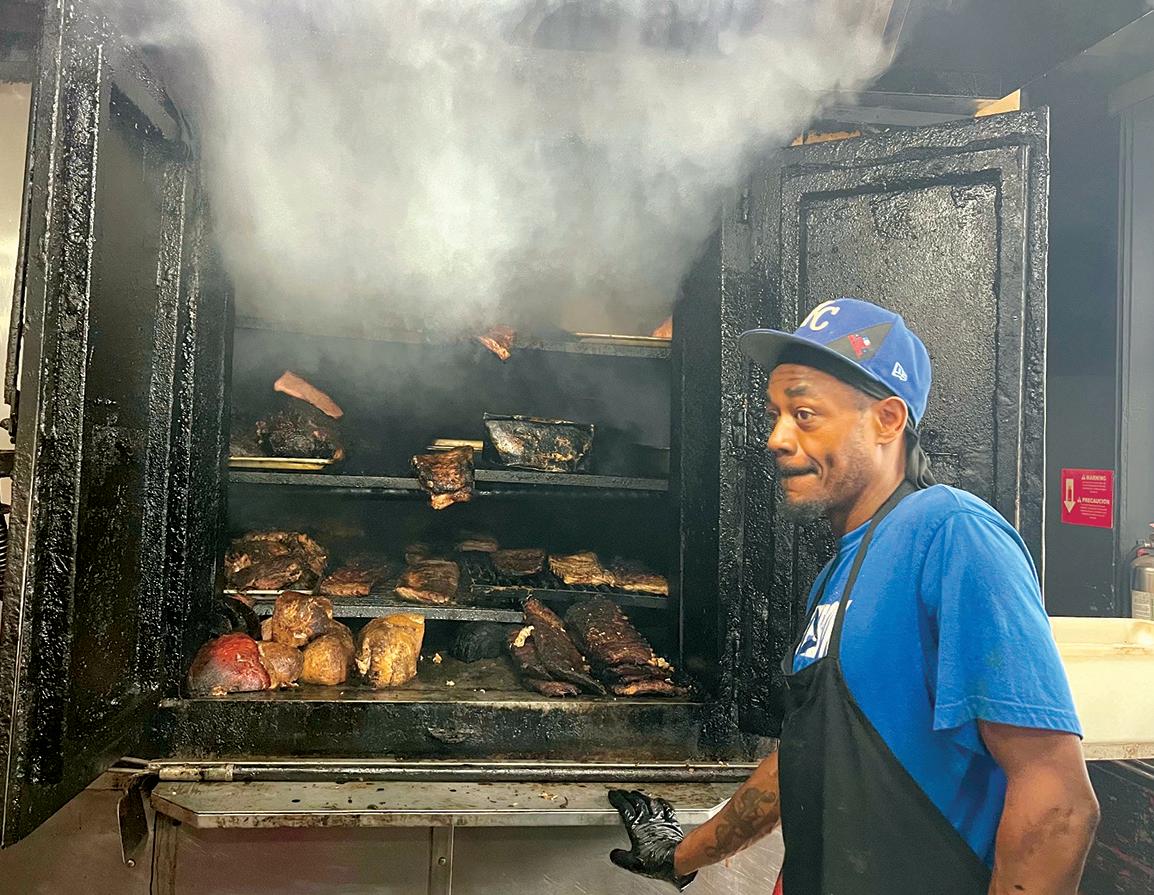
people watching. The heavy traffic surrounding Denver didn’t last long, and we were back on the open road in no time. When it was time to refuel, we pulled off Interstate 70 in Limon, Colorado, where we discovered Oscars. Thinking it was named after someone named Oscar, the decorations inside made it clear that it was named for the Academy Awards. Two large antique theater projectors were placed near the entrance and across the room. The walls were adorned with autographed photos of entertainment and sports celebrities and memorabilia. The menu offered a wide variety of dishes for every taste. It was a great way to refresh ourselves before heading to Kansas City for the night.
Kansas City, here we come
I’m going to Kansas City, Kansas City here I come . . . I’m gonna be stand on the corner
Twelfth Street and Vine
– “Kansas City” Wilbert Huntington Harrison, 1959
Staying overnight at an airport hotel has its benefits – among short stay guests from families catching early morning and crews catching even earlier flights. By 9 a.m. breakfast is plentiful and there are lots of seats. An early start allowed us to arrive at two “must see” Kansas City museums, the American Jazz Museum and the Negro Baseball League Museum (NLBM), in the first hour they opened. We got close to “12th Street and Vine,” but due to street paving improvements, we didn’t get there. Finding parking was easy and we were warmly greeted at the Jazz Museum by Ronnie Medlock at the information desk. Across a spacious atrium is the NLBM. Both have creative, impressive, detailed displays. Bob Kendrick, president of the Negro Leagues Baseball Museum, entranced vis-
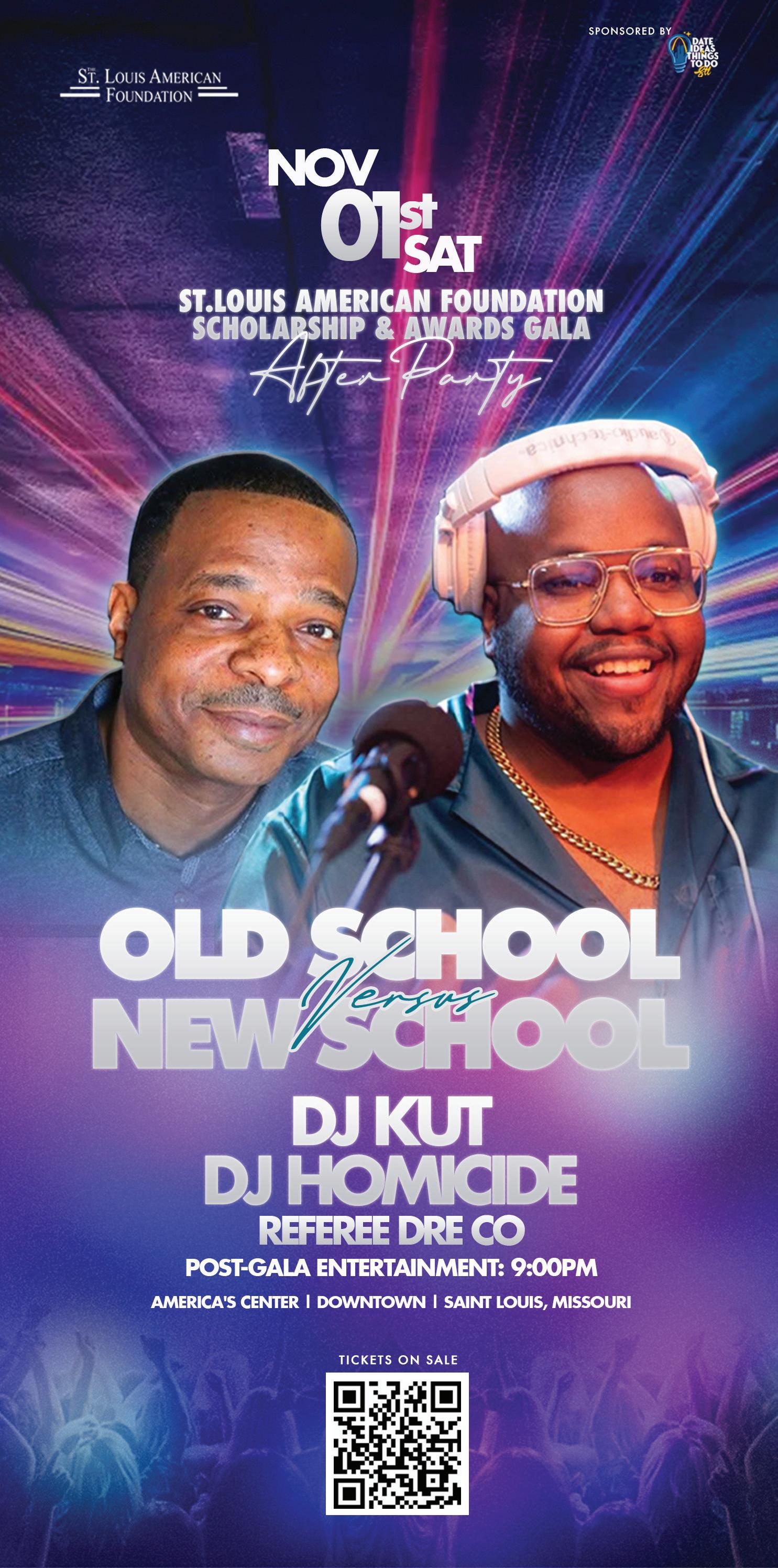
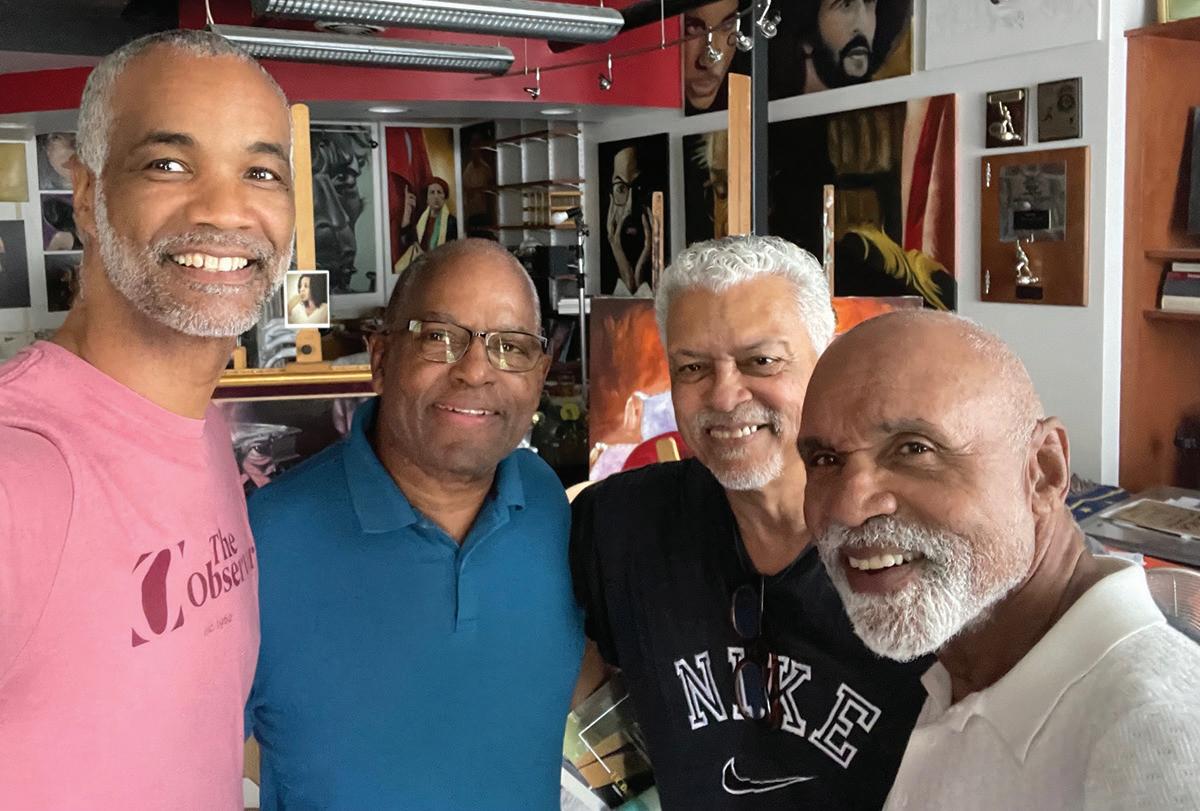
itors with his knowledge and personalized stories of Negro League teams, players and experiences. Kendrick is known as the Chief Storytelling Officer. You can easily spend hours going through the displays.
Of course, you can’t go to Kansas City without savoring the smell, taste and flavor of its distinctive ribs and sides. BBQ expert Adrian Miller, author of “SMOKE,” recommended LC’s Bar-B-Q. The rib joint also serves smoked turkey, ham, pork ribs/ burnt ends, chicken wings, baked beans, coleslaw, potato salad and other sides. Arriving late in the afternoon on a day the Chiefs were scheduled to play, we expected a crowd. Instead, there was a steady flow of patient customers from the “Chiefs Kingdom” waiting in line to satisfy their appetites. Service was prompt and some customers took a seat inside with their takeout orders to sample the fare. Getting to St. Louis was easy although traffic can be heavy on I-70. After a brief stop in Columbia, home of the University of Missouri (Mizzou), and a visit to Michael Middleton, the former interim President of the university, we were on to Clayton to stay at the home of old friends.
On the itinerary was a solemn yet celebratory event. The funeral and repast for Anita Bond allowed time for community with all who had benefitted from her life and contributions to St. Louis.
The last leg of the journey put us back on I-70 for the seventh day of the drive. It was smooth with light traffic over the Mississippi River and past the Jackie Joyner-Kersee center in East St. Louis, Illinois. Stops for snacks and fuel in Kentucky and West Virginia made it a little more than 15 hours to reach the National Mall in the nation’s capital, including across the Frederick Douglass Bridge.

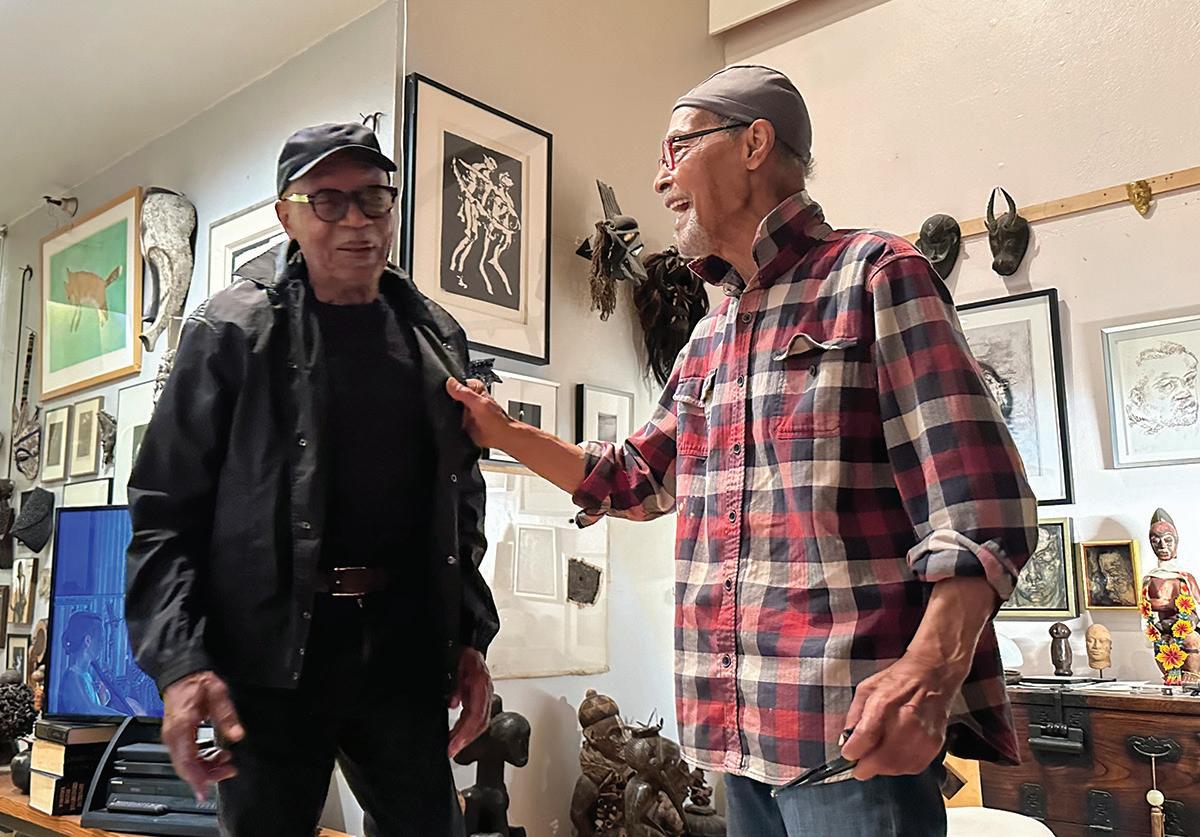

the way it was hard to fight the lure of leaving the highway to visit Louisville and the Muhammad Ali Center, but that would have to wait for another day.

On
Michael Dutton is a communications and public policy consultant based in Washington, DC.
Photo by Michael Dutton for the St. Louis American Contributing editor Fred Sweets in his favorite place, cruising the highways.
Photo by Fred Sweets/St. Louis American
Reggie Hawkins tends to the massive smoker at LC’S Bar-B-Q in Kansas City.
Photo by Fred Sweets/St. Louis American LC’S Bar-B-Q in Kansas City.
Photo by Fred Sweets/St. Louis American Donald Suggs is welcomed to the home of Oliver Lee Jackson in Oakland, California.
Larry Lee, (left) publisher of the Sacramento Observer, makes a selfie with Michael Dutton, artist Tracy Winston, and Fred Sweets in Winston’s gallery in Sacramento. Winston is originally from East St. Louis, Illinois.
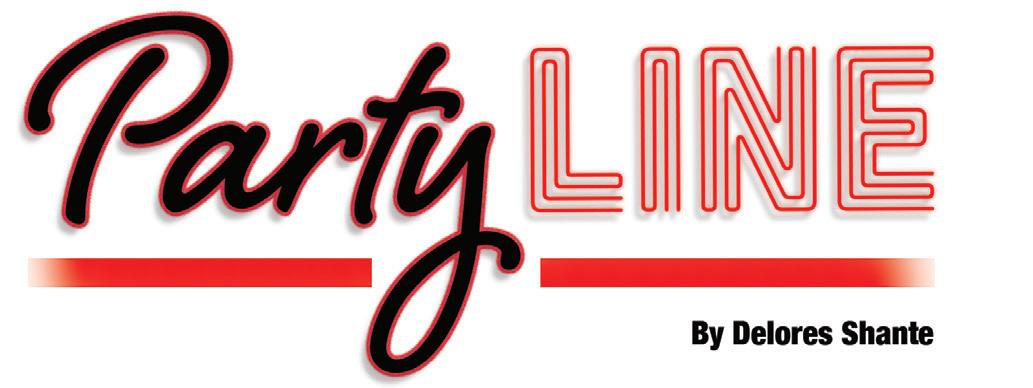
The Salute countdown begins. That’s right, we are just about a month out from the blueprint for top tier galas of Black St. Louis. The St. Louis American Foundation’s 38th Annual Salute to Excellence in Education Scholarship and Awards Gala will take place November 1 at America’s Center. I’d tell y’all I’ve attended them all, but we know I’m only 31. I’ve been to plenty though, and a time has been had at every.single.one. Now that’s not to say that I haven’t had my wardrobe challenges. There was the time where I fell off my annual Salute diet a week before the gala. My dress was so tight, I had to breathe like the late great Danny Aiello in that safe in “Harlem Nights.” There was also the year that “The Wobble” came out. My gown clearly didn’t have enough wiggle or wobble room. When the song said, “Hey big girl, make ‘em back it up,” I absolutely did. Sadly, the back of my dress popped open like a can of Pillsbury Grands. And finally, there was the time when I made the poor life choice of downsizing on my Body Magic. Y’all, this shape of mine was stiffer than a wig in a Tyler Perry movie (yes, that applies to “Ruth and Boaz” too)! Anyway, I started my 30-day body transformation program yesterday. If you catch a stray side eye or a random spicy clapback from me out of nowhere between now and November 1, blame it on the calorie deficit.

Dr. Tonia Collins Smith are reliable. So is this year’s stellar performer honoree Mary Elizabeth Grimes. I already know she will be bringing that heat to the stage if she was wearing what looked to be an Oscar de la Renta suit in the photos for the feature on her in the paper! And Janet Williams popped out and popped off in that black lace Valentino jumpsuit last year! The men aren’t to be slept on either. Vincent Flewellen of Webster University and Dr. James T. Minor of SIUE are prime examples. In related news, I know some folks have expressed concern over ticket costs for this year. In the words of 21st century philosopher and thought leader Fat Joe, “Yesterday’s price ain’t today’s price.” But in all seriousness, pouring into our babies has a 100 percent return on investment.
I know money is tight right now, but the ticket prices for this year’s Salute are less than the median price of a pair of new release Jordans. And you don’t get a plate of good food, surrounded by the best people and the opportunity to praise our region’s educators while supporting scholars. Oh, and did I mention a litty lit after party?


Salute fashionistas. Enough about me, let me take a moment to shout out the folks who faithfully slay with their formal fashions. Dr. Kaci Shahid and
Public Enemy’s Picasso. I was September 12th years old when I found out hip hop icon Chuck D was also a visual artist. I stumbled upon his work in Legends Gallery when I was searching for an emergency cooling center during MATI. I am not the least bit mad it! He was in town with Public Enemy as a headliner for Evolution Music Festival in Forest Park and was gracious enough to
make not one, but two stops to the gallery to meet, greet and discuss his work. Friday night was at capacity to the point where people had to wait until other people came out before they could come in. Carrie and Keith Griffin of Delux, St. Louis Poet Laureate Pacia Elaine Anderson, multihyphenates Cheeraz Gormon and David A.N. Jackson, fellow hip hop legends Charlie Chan Soprano and G Wiz were just a few of the folks who came through. Folks were really impressed by his work – and they should have been – and he was eager to chop it up with people about it. I could tell he felt a type of way when I asked him about his skin care regime and didn’t utter a peep about his paintings. I couldn’t help it. He
looked like he hopped right out of 1989. He’s clearly been fighting the power with retinol and collagen!
TLC experience Tish Haynes. Speaking of Evolution Fest headliners, at this point it’s been everywhere – even on the “Today Show,” y’all – but I have to give a shout out to the moment Tish Haynes had with music group TLC over the weekend. Can you imagine minding your business and doing your set at Broadway Oyster Bar and Chilli and T-Boz just pop in as you are singing “Waterfalls?” First of all, had they heard me on the microphone, they would have pulled a Dionne Warwick and walked on by. They were riding in a van with the windows down and pulled up on Tish and
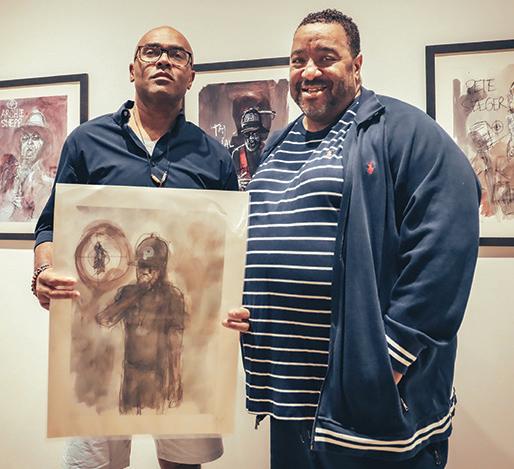
‘nem’s set. Then proceeded to get life from her cover. Girl, if this isn’t a clue about your destiny, I don’t know what is! The odds of this happening is astronomical by itself. The fact that this happened to someone who placed in the top 24 on “The Voice” is confirmation from the universe. Tish, miss girl, was that you who hit that Mega Millions at the Quik Trip on Lusher Road? Because this is along those lines as far as favor goes.






1. Ohun Ashe came through to support KVTheWriter @Strawberry
Bounce Thursday night @ Tschüss
2. Chris Pulphus of Kranzberg Arts Foundation with rap legend Chuck
D Friday night @ Legends Gallery for reception for Chuck’s exhibition, on view through Nov. 12
3. Alexis Adewunmi (@a.ao.a) and Natasha Sykes (@druiddesignsstlat) at Strawberry Bounce Thursday night at Tschüss
3. Carter was proud to show off his purchase of a print by Chuck D
to STL’s own hip hop legend Charlie Chan Soprano Friday night at Legends Gallery
Photos by Taylor Marrie/St. Louis American
“Year after year, the only thing that remains consistent is a lack of accountability from our leaders.”
— WNBA star and St Louisan Napheesa Collier on league leadership

prEp Football NotEbook
With Earl Austin Jr.
After retooling, Crusaders continue winning ways
The Lutheran North Crusaders are annually one of the top programs in the St. Louis area and Missouri.
Lutheran North defeated Festus 46-7 last November to win the Class 4 state championship, which was the seventh in the school’s storied history.
Since winning the state title, the Lutheran North program has had to do a lot of retooling. The first change came at the top when Kyle Wagner stepped down as head coach to become an assistant coach at Sacramento State. The new coach is Lorenzo Brinkley, who is a veteran on the sidelines in the area as a head coach and offensive coordinator. The Crusaders also had to replace many talented players from last year’s championship team, but Brinkley has things moving in the right direction with a 3-1 record.
300 yards and scored six touchdowns.
There are several excellent wide receivers that Moore can throw the ball to. Senior speedster Mike Clark has 10 receptions for 238 yards and two touchdowns. He is also a state champion sprinter in track and field.
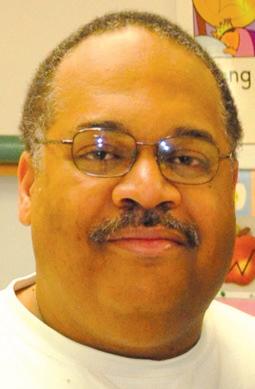
Junior Kyren Evans has 12 receptions for 268 yards and three touchdowns.
Seniors Osar Tate and Que Whitfield are also talented receivers. Tate has three touchdown receptions on the season.
Lutheran North will host MICDS on Friday night in a big Homecoming game which will also decide the championship of the Metro League. The Crusaders also have dates with always-tough Maryville and a showdown with Cardinal Ritter on the last night of the regular season.
The Undefeated
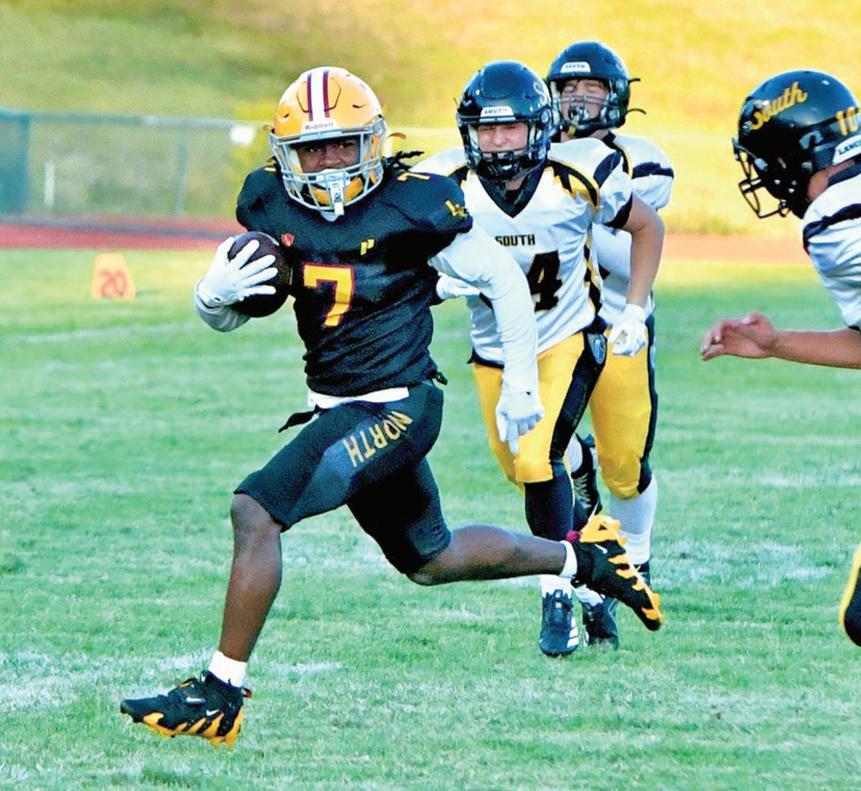
One top returning player is junior quarterback Jonothan Moore, who has passed for 790 yards and 10 touchdowns. He has also scored four rushing touchdowns.
Lutheran North also has an abundance of talented skilled players who are big-play performers. Senior running back Martez Stephenson has rushed for nearly
As his grueling rehabilitation from an Achilles injury in Game 4 of the NBA East Conference semifinal series against the New York Knicks continues, St. Louis-born NBA star Jayson Tatum says his son Deuce has been an inspiration.
“We were sitting on the couch watching some of my high school and college highlights and I asked him ‘You think Daddy’s going to come back and be able to do that again?’” Tatum shared with ESPN NBA Today host Malika Andrews.
After five weeks of high school football, we still have five teams in the St. Louis area who have undefeated records. The area teams with 5-0 records are CBC, SLUH, Lafayette, Jennings, Orchard Farm, Gateway STEM, St. Dominic, Summit and Festus.
Xavier Jackson commits to Wyoming Standout lineman
Xavier Jackson of Fort Zumwalt North has given a commitment to Wyoming. The 6’3” 270pound Jackson is one of the top defensive lineman in the area. Through five games, he has 19 total tackles with two quar-
terback sacks and two tackles for losses for the 4-1 Panthers. As a junior, Jackson had 61 tackles, with seven quarterback sacks and nine tackles for losses.
Highlight Performers from Week 5 • Junior running back Cam Sharp of DeSmet
SportS EyE
With Alvin A. Reid
rushed for 225 yards on 33 carries and scored a touchdown in the Spartans’ 56-42 victory over Vianney.
• Senior wide receiver Tim Washington of Lafayette had seven receptions for 120 touchdowns and two touchdowns in the Lancers’ 35-0 victory over Pattonville. He also had two interceptions on
Tatum hasn’t ruled out late-season return
“I’ve played this in my head a thousand times; what happens if I never got hurt?” Tatum said on ESPN.
“I’m not going to say what would’ve happened, but I just know I’ve been down 3-2 on the road three times in my career, and I was 3-0.”
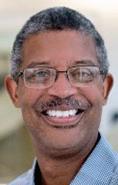
“In an innocent way, he looked at me and said, ‘Of course.’ I really needed that.”
Tatum’s torn Achilles tendon ended his season, and his Boston Celtics would be bounced from the playoffs by the Knicks in Game 6. The former Chaminade High School and Duke University blue-chip player, who is now among the highest-paid NBA stars, thinks his injury cost his team the series.
Tatum is steadfast that he could return to action before the end of the 2025-26 season. He is at a new benchmark in his recovery. He wants to “gradually keep increasing, ramping up.”
“It’s been a long, long journey,” he said. “I reflect on the surgery. Then you get the stitches out, to (removing) the walking boot. At four weeks, you’re at 50% of weight bearing.
“The important thing is full recovery, making sure I’m 100% healthy before I step back out on the floor.”
He had his first on-court workout last week, which he called “a relief.”
Tatum said he has confided in his mom, trainers,

and friends that he will have a date marked on the calendar for his return. He has not set the date, but he has a plan.
“Whenever that day is, it will be at a home game before the fans at the TD Garden,” he said.
Tatum recorded a stellar 2024-25 regular season and had the Celtics primed for a chance to repeat as NBA Finals champions. In 72 games, Tatum averaged 26.8 points, 8.7 rebounds and six assists.
Tatum posted 28.1 points, 11.5 rebounds and 5.4 assists in eight games
in the 2025 playoffs before his injury. Should he return before season’s end, he will rejoin a different Celtics team than the one he left in May during the playoffs.
Gone are Jrue Holiday and Kristaps Porzingis from the roster that won the 2023-24 title.
Bench players Luke Kornet, Al Horford and Torrey Craig are on new teams, while the Celtics added Anfernee Simons, Chris Boucher and Luka Garza.
“I’m super excited about this team we have.
Jayson Tatum’s 2024-25 season ended when he tore his Achilles tendon in Game 4 of an NBA East Conference playoff series against the New York Knicks. He has not surrendered to the notion he won’t play again this season.
Throughout this business, throughout the NBA, there is always going to be change,” he said.
“You won’t be able to keep the same team forever. Now it’s a new chapter, a new journey, and I couldn’t be more excited about it.”
Tatum sounds determined to play again once spring 2026 rolls in. I would not bet against it.
The Reid Roundup
The first of the 14 Black quarterbacks who started Week 1 in the NFL
defense.
• Junior Jonathan Moore of Lutheran North passed for 201 yards and three touchdowns in the Crusaders’ 57-7 victory over Lutheran North.
• Senior quarterback Nick McClellan of CBC passed for 271 yards and touchdowns and rushed for 133 yards and two TDs in the Cadets’ 65-33 victory over Lipscomb.
• Senior quarterback Sam Deen of Vianney completed 31 of 47 passes for 532 yards and six touchdowns in the Golden Griffins’ loss to DeSmet.
• Junior quarterback Ta’Vren Williams of North Point completed nine of 14 passes for 184 yards and three touchdowns in the Grizzlies’ 22-0 victory over Fort Zumwalt East.
• Senior running back Vic Williams of CBC rushed for 169 yards, caught two passes for 69 yards and scored three touchdowns in the Cadets’ 65-33 victory over Lipscomb.
• Senior wide receiver Mike Clark of Lutheran North had four receptions for 120 yards and scored a touchdown on a 43-yard punt return in the Crusaders’ 57-7 victory over Lutheran South.
• Junior wide receiver Royce Searcy of DeSmet had nine receptions for 135 yards and two touchdowns in the Spartans’ 56-42 victory over Vianney.
to be benched is Russell Wilson. The New York Giants tabbed rookie Jaxson Dart as starter for the remainder of the year…Washington Commanders QB Jayden Daniels will miss a second game with a sprained knee. He says his return is up to team doctors…Michael Penix was awful in the Atlanta Falcons’ 30-0 loss to the Carolina Panthers and was replaced in the game by Kirk Cousins. Coach Raheem Morris says Penix is in no danger of losing his starting role… Add another Black QB starter to the 2025 mix. Veteran Tyrod Taylor stepped in for the New York Jets last week as starter Justin Fields recovered from a concussion…According to NFL.com QB rankings, Baltimore QB Lamar Jackson is No. 3, followed by Kansas City Chiefs signal caller Patrick Mahomes at No. 4. They square off on Sunday at Arrowhead Stadium…Philadelphia Eagles QB Jalen Hurts is also in the Top 10 at No. 6.
Earl Austin Jr.
Alvin A. Reid
Lutheran North running back Mike Clark (7) is on his way to the team’s first touchdown of the day against cross town rivals Lutheran South. The Crusaders of Luthran North would go on to defeat the Lancers of Lutheran South 57-7.
Photo by Wiley Price / St. Louis American
Photo courtesy of Celticsblog.com


NOTICE TO CONTRACTORS
SOLICITING SEALED BIDS
Lunda Construction is requesting quotes for the following project: MoDOT
I-70 Rocheport to Columbia
Quotes due: 11/4/25
A Non-Disclosure Agreement (NDA) is required before we can share plans with you.
Please call 651-437-9666 to request the NDA.

PUBLIC NOTICE
Notice is hereby given that the Metropolitan St. Louis Sewer District Requests for Quotes, Bids and Proposals are posted online for public download. Please navigate to www.msdprojectclear.org
> Doing Business With Us
> View Bid Opportunities
Metropolitan St. Louis Sewer District is an Equal Opportunity Employer.
Sealed bids for the Craig Road Resurfacing project, St. Louis County Project No. AR-1562, Federal Project No. STP-5563(602) will be received electronically thru the County’s Vendor Self Service portal at https://stlouiscountymov endors.munisselfservice. com/Vendors/default. aspx, until 2:00 PM on October 29, 2025.
Plans and specifications will be available on September 29, 2025 from the St. Louis County Web Site (www.stlouiscounty mo.gov) or by contacting Cross Rhodes Print & Technologies, 2731 South Jefferson Avenue, St. Louis, MO 63118 (314) 678-0087.
DIRECTOR OF PROCUREMENT AND ADMINISTRATIVE SERVICES ST. LOUIS COUNTY

NOTICE TO SMALL (SBE), DISADVANTAGED (DBE), MINORITY (MBE), & WOMEN’S (WBE), SERVICE DISABLED VETERAN OWNED (SDVOB) & VETERAN OWNED (VOB) BUSINESSES ADVERTISEMENT RIVER CITY CONSTRUCTION, L.L.C., 6640 AMERICAN SETTER DRIVE, ASHLAND, MISSOURI 65010, (573) 657-7380 (PHONE) (573) 657-7381 (FAX) IS SEEKING QUALIFIED SMALL, DISADVATANGED, MINORITY, & WOMEN’S BUSINESSES FOR THE UNIVERSITY OF MISSOURI CHAMPIONS DRIVE SUBSTATION 69KV TRANSFORMER FOUNDATIONS FOR THE SUBCONTRACTING OPPORTUNITIES IN THE FOLLOWING AREAS: CONCRETE, METALS, ELECTRICAL, AND EARTHWORK. ALL INTERESTED AND QUALIFIED SMALL, DISADVANTAGED, MINORITY AND WOMEN’S BUSINESSES SHOULD CONTACHT, IN WRITING, (CERTIFIED LETTER, RETURN RECEIPT REQUESTED) JR PETERSON, TO DISCUSS THE SUBCONTRACTING OPPORTUNITIES. ALL NEGOTIATIONS MUST BE COMPLETED PRIOR TO THE BID OPENING BID DATE OF 10/14/2025 @ 1:30 PM. PROPOSALS WILL BE EVALUATED IN ORDER ON THE BASIS OF LOW RESPONSIVE BID RECEIVED.CERTIFICATION OF DBE/WBE/ MBE/SDVOB/VOB STATUS MUST BE SUBMITTED WITH BID. BID DOCUMENTS MAY BE OBTAINED BY:
1) Email your company name, contact name, and phone number, as well as the project you are interested in to bid@rccllc.com
2) You will then receive an email invitation for that project with a link to our SmartBidNet system. River City Construction, LLC is an Equal Opportunity Employer.

NOTICE TO SMALL (SBE), DISADVANTAGED (DBE), MINORITY (MBE), & WOMEN’S (WBE), SERVICE DISABLED VETERAN OWNED (SDVOB) & VETERAN OWNED (VOB) BUSINESSES ADVERTISEMENT RIVER CITY CONSTRUCTION, L.L.C., 6640 AMERICAN SETTER DRIVE, ASHLAND, MISSOURI 65010, (573) 657-7380 (PHONE) (573) 657-7381 (FAX) IS SEEKING QUALIFIED SMALL, DISADVATANGED, MINORITY, & WOMEN’S BUSINESSES FOR THE HARRIS STOWE STATE UNIVERSITY NEW STEM BUILDING FOR THE SUBCONTRACTING OPPORTUNITIES IN THE FOLLOWING AREAS: DEMOLITION, CONCRETE, METALS, WOOD & PLASTICS, THERMAL & MOISTURE PROTECTION, OPENINGS, FINISHES, SPECIALTIES, EQUIPMENT, FURNISHINGS, CONVEYING SYSTEMS, FIRE SUPPRESSION, PLUMBING, HVAC, INTEGRATED AUTOMATION, ELECTRICAL, COMMUNICATION, ELECTRONIC
Great Rivers Greenway is soliciting sealed bids for St. Vincent Greenway: Signage Replacement Project in St. Louis, Missouri. For details visit www.greatriv ersgreenway.org/ bids/ and submit by October 23, 2025.
SEALED BIDS
Bids for Install Access Points for Wi-Fi at Missouri Veterans Home, Bellefontaine Neighbors, Project No. U2411-01, will be received by FMDC, State of MO, UNTIL 1:30 PM, October 28, 2025. Project information available at: http://oa.mo. gov/facilities

OWNED (SDVOB) & VETERAN OWNED (VOB) BUSINESSES ADVERTISEMENT RIVER CITY CONSTRUCTION, L.L.C., 6640 AMERICAN SETTER DRIVE, ASHLAND, MISSOURI 65010, (573) 657-7380
SEALED BIDS
Bids for Interior & Exterior Renovations Missouri 4H Building, Project No. F2407-01 will be received by FMDC, State of MO, UNTIL 1:30 PM, 10/30/25. Project information available at: http://oa.mo. gov/facilities
URBAN LEAGUE OF METROPOLITAN
ST LOUIS – RFP
JANITORIAL
GENERAL BUILDING
SITE LOCATIONS (SERVICE (A)) AND HEADSTART
SITE LOCATIONS (SERVICE (B))
The Urban League of Metropolitan St. Louis requests bids for the Janitorial service at various sites. Go to:https://www.ulstl. com/request-forproposal-rfp.html#/
Submit electronic Bid
Date: October 23, 2025 @ 2:00 pm to arussellperry@ urbanleague-stl.org
Questions Deadline: October 9,2025
Questions shall be addressed in writing to: Rodney Williams, rwilliams@ urbanleague-stl.org, cc: arussellperry@urban league-stl.org
SEALED BIDS
Bids for Improvements for Infection Control, Mount Vernon Veterans Home, Project No. U2301-04 will be received by FMDC, State of MO, UNTIL 1:30 PM, 9/25/25. Project information available at: http:// oa.mo.gov/ facilities
SEALED BIDS
Bids for Geological Survey, Replacement of HVAC and Upgrade Lighting, Buehler & Annex Buildings, Rolla, MO, Project No. W2401-01 will be received by FMDC, State of MO, UNTIL 1:30 PM, October 23, 2025. Project information available at: http:// oa.mo.gov/ facilities
SEALED BIDS
Bids for REBID Renovate Interior & Exterior at St. Clair Readiness Center, Project No. T2326-01, will be received by FMDC, State of MO, UNTIL 1:30 PM, October 2, 2025. Project information available at: http://oa.mo. gov/facilities
SEALED BIDS
Bids for Repairs to Building Exterior and Replace Windows at Helen M. Davis State School, Project No. E2412-01, will be received by FMDC, State of MO, UNTIL 1:30 PM, October 23, 2025. Project information available at: http:// oa.mo.gov/ facilities
SEALED BIDS
Bids for New Director’s House, Missouri State Fairgrounds Project No. F2402-01 will be received by FMDC, State of MO, UNTIL 1:30 PM, November 4, 2025. Project information available at: http://oa.mo. gov/facilities
SEALED BIDS
Bids for Replace Carpet and Paint, Suite 670 Revenue, Project No. O2421-01 will be received by FMDC, State of MO, UNTIL 1:30 PM, October 28, 2025 Project information available at: http:// oa.mo.gov/ facilities

‘How you die does not redeem how you lived’
Black pastors condemn
Kirk’s
murder but reject his martyrdom
By Rev. Dorothy S. Boulware Word in Black
When he stepped to the podium at Alfred Street Baptist Church in Alexandria, Virginia, last month, Rev. Dr. HowardJohn Wesley had a message for his congregation about the broad-daylight murder of Charlie Kirk, the far-right political activist.
Within an hour of the end of the 8 a.m. service, the entire world had heard what he said; Kirk didn’t deserve to die, but he was no hero, either.
“I’m overwhelmed to see the nation’s flag flying half-staff for a man who was a proud racist and spent his entire life sowing seeds of division and hatred into this land,” Wesley told the congregation in a video that immediately went viral.
“And then these hypocrites with selective rage who are mad about Charlie Kirk but didn’t say anything about [Democratic Speaker of the Minnesota House of Representatives] Melissa Hortman and her husband when
they were gunned down in their living room.”
As the shock waves of Kirk’s assassination on Sept. 10 continued to reverberate, Wesley and other Black pastors across the country grappled with how to respond to the killing. Kirk, whose combative, racially incendiary rhetoric made him a darling of the right — and a Trump administration insider — as well as a lightning rod for critics. Balancing sympathy and truth
Almost to a person, the Black ministers who spoke about Kirk in their Sunday sermons and messages condemned the violence, declaring that Kirk’s murder was unjustified. They recalled the legacy of Martin Luther King Jr. and other civil rights leaders who used the church to call for justice, peace and civic engagement.

In a sermon that went viral on social media, Rev. Dr. Howard-John
Wesley, senior pastor of Alfred Street Baptist Church in Alexandria, Virginia. was among the Black ministers nationwide who spoke on Kirk’s death just days after the assassination in Utah.
and women like Wesley,
January,
the line between condemning the killing of Charlie Kirk and condemning the incendiary, racist views Kirk held during his lifetime.
not partisan fervor.

But they also argued that, like King, their duty in this historic moment is to offer moral clarity,
In sermons and statements, they condemned Kirk’s message, which included attacks on racial equity efforts, LGBTQ rights, social justice and even King himself. They pointed out that Kirk’s rhetoric fueled division and endangered marginalized communities. And they warned that, despite the outpouring of shock and sympathy over his death, Kirk is not a martyr. Those values were on display in Wesley’s sermon. He donned the prophetic mantle and said Kirk’s death at the hands of an assassin, in front of a crowd of thousands of young people at a Utah rally, does not outweigh his life.
“There’s nowhere in the Bible where we’re told to honor evil,” he said. “How you die does not redeem how you lived. Your


death does not make you a hero, one who should be honored or respected. I can be sorry about your death and not celebrate your life.”
He went on: “It’s tiring being Black in America. It’s exhausting defending your existence everywhere you go. It’s an assault on my identity to keep seeing this nonsense in our nation, and I am overwhelmed.”
‘America is a powder keg’
In the same vein, Rev. Dr. Gina M. Stewart addressed her congregation at Christ Missionary Baptist Church in Memphis — the next city Trump has slated for occupation by the National Guard.
“I cannot act like violence is not real, particularly in a city that is Black and in a congregation that is Blackety Black. America is a powder keg waiting
What’s Really Driving You?
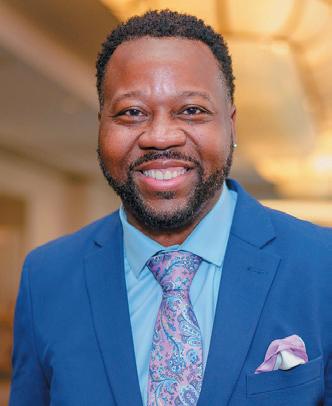
Every leader has a story. But sometimes, it takes just one question to reveal the deeper truth behind that story.
Recently, I was interviewed by Corporate Faith, a platform I admire for asking real questions to real people trying to live out their faith in real time.
In the middle of our conversation, I was asked:
“Why do you push yourself so hard?”
I had my standard answer ready. Normally, I’d say it’s about legacy — making sure I leave something meaningful for my family in the short time I have on this earth. That’s true. And for years, it’s been the truth I leaned on.
But in that moment, I didn’t say that. I said, almost without thinking: “Because I don’t want to let God down.”
The words caught me off guard. They weren’t rehearsed — they just came out. And I’ve been sitting with them ever since.
From Pressure to Purpose That answer had always been there, like a quiet soundtrack in the background of my life. It was there in the long nights of study. It was there in the uphill climbs of leadership. It was there every time I kept going when quitting would’ve been easier. I don’t want to let God down — because I know He orchestrated this drive in me. He lined up the people who believed in me when I didn’t believe in myself. He opened doors when my lack of credentials and pedigree should have kept them shut.
I’ve walked a long road — from foster care to boardrooms. Along the way, I’ve learned to carry opportunity with reverence. I push hard because I’ve seen too much grace to treat it
to explode,” Stewart said. “I am weary of the rhetoric that is so filled with venom and hatred that poisons our common life.”
While Kirk did not personally advocate for violence, he was known for rhetoric ”that fuels division and even death,” she said, pointing out “unfounded and unfair retaliation against those on the so-called left” that had nothing to do with Kirk’s murder.
“Several of our HBCUs were even targeted — a chilling reminder of how quickly violence can be sanctified, baptized, and how easily hate can dress itself up as virtue,” Stewart said.”
No comparison with King
Dr. Frederick Douglass Haynes III, senior pastor of Friendship West Baptist Church in Dallas, rebuked those who compared Kirk’s murder to King’s assassination.
“A white Christian Nationalist gets killed, not assassinated,” Haynes said. “Martin King was assassinated. Medgar Evers was assassinated. Malcolm X was assassinated. Don’t compare Kirk to King.”
“I’m anti-political violence. Kirk should still be alive,” he said. “I don’t agree with anything Kirk said. What he said was dangerous. It was racist. It was rooted in white supremacy. But he should still be alive, playing with his kids. I don’t want anybody to be victimized by political violence.”
He then lit into anyone who would say Kirk’s murder goes against American values.
“If you ever say ‘America, we’re better than this,’ you’re lying,” he said. “We’re not better than this. America was born in political violence. Committed political violence in the slave trade. Committed political violence with ‘strange fruit’ on Southern trees. Committed political violence against the Irish and against Italians — before they became white.”
casually. I’ve been carried when I should’ve fallen. Now I run — not just to honor those who helped me, but to honor the One who’s been with me the whole time.
A Leadership Truth
Here’s the lesson I want to leave with you: as leaders, we often talk about vision, strategy, and execution. But none of that sustains us without a deeper “why.”
Pressure can drive performance for a season.
Purpose drives transformation for a lifetime.
Legacy matters. But purpose sustains.
A Transformation Arc
When I look back, my life itself is the proof:
• From a foster child who should’ve been a statistic…
• To a nonprofit leader trying to open doors for others…
• To a bank CEO carrying the responsibility of thousands of customers and employees…
That’s not just hustle. That’s grace. And it’s purpose.
A Reflection Exercise
So let me turn the question to you.
Take a few minutes and ask yourself:
1. What’s quietly driving me that I haven’t named yet?
2. Is it external pressure — or internal purpose?
3. Would I be proud to say it out loud?
Because when you can name it, you can harness it. And when you harness it, you can lead — not from exhaustion, but from transformation.
Final Thought Sometimes the questions we least expect uncover the truth we most need.
For me, the truth is this:
I push hard not because of pressure, but because of purpose. What about you?
Photo by Jada Ingleton/The Washington Informer
Clergymen
pictured here in
walked
The Next MOVE
